Barcelona, the vibrant capital of Catalonia, is a captivating city that blends fascinating history and rich culture with a modern outlook and an infectious zest for life. In this intoxicating city, you can gaze in awe at Gaudi’s masterpieces, wander the winding streets of the Gothic Quarter, marvel at the chaos of Las Ramblas and scale the scenic heights of Montjuïc. You can relax on a golden sand beach, shop luxury designers in Eixample, catch a football game, eat your body weight in tapas, and then party till dawn!
Barcelona has unlimited attractions for all tastes, but with all that going on, it can take time to get your bearings. This is why we’ve put together this A to Z of Barcelona so you can start understanding this captivating city and planning your ideal city break.
We’ll help you decide which of the diverse districts to visit, teach you how to eat like a local, explain why Catalonia is not just another region in Spain, show you how to jump the queues at the Sagrada Familia, and explain why you should never order Vermouth after dark!
Let’s get started!
A | B | C | D | E | F | G | H | I | J | K | L | M | N | O | P | Q | R | S | T | U | V | W | X | Y | Z
Architecture
It’s fitting that this topic comes at the start of the guide because architecture is one of the first things that spring to mind when you think of Barcelona. This city’s landscape is a treasure trove of fascinating buildings spanning a range of eras, architectural styles and movements.
Although there are countless examples of stunning architecture in Barcelona, it is the works of Antoni Gaudi that have become emblematic of the city. The Spanish architect and designer was renowned for his unique blending of styles, including Catalan modernism, art nouveau and gothic-revival, to create colourful, whimsical structures inspired by nature and fantasy. Examples of Gaudi’s work are scattered throughout the city and are, for some, a key reason to visit Barcelona.
Some come purely to see Gaudi’s unfinished masterpiece, the Sagrada Familia. This breathtaking UNESCO-listed basilica is an astounding blend of intricate facades, towering spires and surreal imagery. Elsewhere in Barcelona, Gaudi fans can visit the beautifully undulating Casa Mila (also known as La Pedrera) and the groundbreaking Casa Batlló with its roof inspired by a dragon’s spine. And, of course, the enchantingly iconic Park Güell, with its instantly recognisable mosaics, monuments and natural imagery.
Alongside the colourful chaos of Gaudi’s works, you can explore the old town and Gothic Quarter where you can wander ancient streets filled with mediaeval buildings. There you can gaze at the traditional Catalan design of the Iglesia de Pi church, visit the gothic splendour of the Barcelona Cathedral and marvel at the imposing yet surprisingly airy Basílica de Santa Maria del Mar.
It’s not surprising that this city has won an award for architecture, but it might be surprising to know that it wasn’t until the 1990s. It was the respectful yet innovative way the city underwent regeneration ahead of the ’92 Olympic Games that earned this city the RIBA Royal Gold Medal award for architecture. This prestigious prize has been running since the 1840s and is usually given to an architect or group of designers. It has never before or since been given to an entire city!
Not content to stay still, the architectural landscape of Barcelona continues to evolve with buildings such as the Torre Glòries joining the mix in 2005. This colourful skyscraper met with mixed reviews. But love it or hate it, it’s a sign that innovation is still occurring in the skyline of Barcelona.

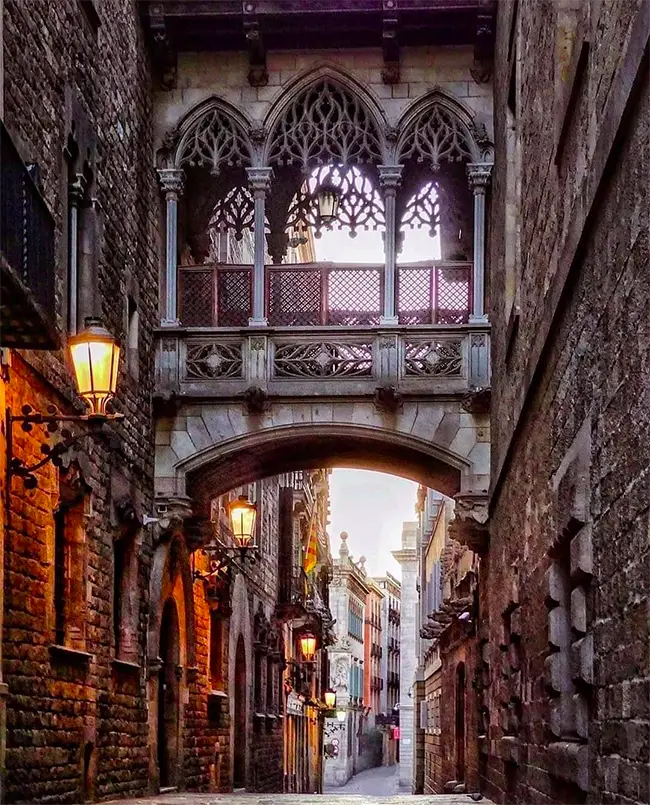
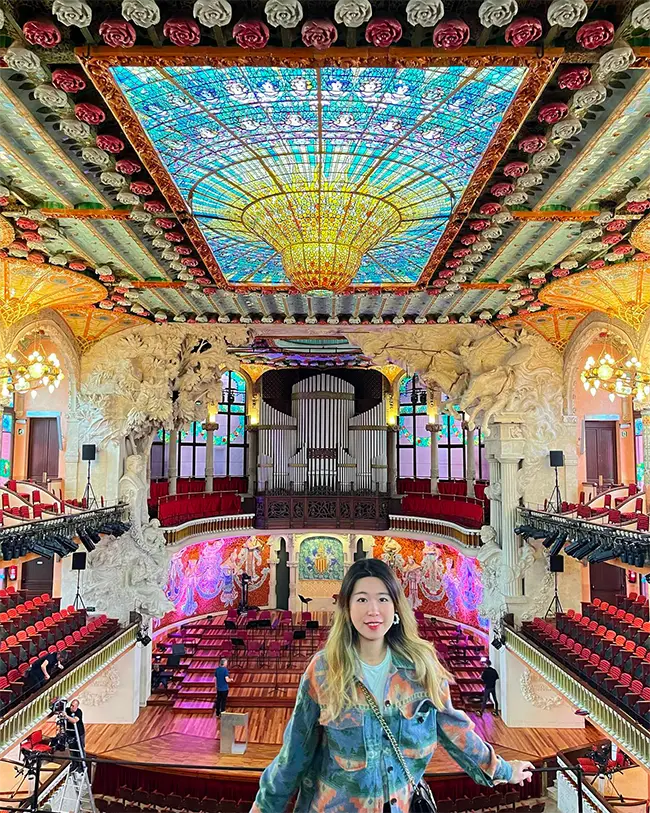
Beaches
A large part of Barcelona’s appeal is that it offers both an urban escape and a beach holiday. The chain of golden sandy beaches fronting the city is a quintessential part of its allure as a destination. And that’s no accident since Barcelona’s beaches are all artificial.
The waterfront before the 1990s was an industrial area with no sand to speak of and certainly not a place you’d want to spend a day sunbathing. Then, as part of a huge regeneration project, the city revamped the entire area, knocking down industrial buildings, trucking in tons of sand and opening up the city to the sparkling sea. A 3½ kilometre stretch of coastline was transformed into the chain of eight promenade-lined beaches that are such a key part of the city’s character today.
Thanks to their custom-built design and city-adjacent locations, each beach offers abundant facilities with lifeguards, toilets, showers, and plenty of nearby cafes, bars and shops. But they also have distinct characters, and we encourage you to spend your holiday exploring them all and picking your favourite!
- San Sebastian is the first of these beaches at the southern end of the coastline. It’s a small spot but popular due to its easy access, beautiful views and nudist area.
- Next comes Sant Miquel Beach, a busy, 420m stretch of sand with excellent accessibility.
- Then there’s Barceloneta, the most famous and popular stretch. Its vibrant atmosphere attracts crowds of international holidaymakers seeking fun in the sun, relaxation, beach games and watersports.
- Continue north past the Olympic Port to reach the next beach, Nova Icària, a beautiful 400m stretch of golden sand and clear blue water that attracts more families than the rowdier southern beaches.
- Next up is Bogatell, one of the quietest beaches, popular with a slightly older crowd.
- Then, 500m long, Mar Bella Beach which has a slight split personality due to its children’s playground at one end and nudist section at the other.
- Nova Mar Bella is a peaceful, laid-back stretch of sand with great access for disabled beachgoers.
- The last stretch of sand, Llevant, is the only officially dog-friendly beach in the city.
- Completing the waterfront is Fòrum. Not technically a beach since there is no sand, it’s a custom-built saltwater swimming pool area perfect for a refreshing dip in the azure waters after you’ve walked or cycled the length of the waterfront.
Don’t fancy any of the city options? Want a more peaceful beach experience? Then head out of town to the neighbouring beaches of Ocata or Sitges, where the locals go to escape the tourist crowds.
Or take a day trip to the stunning beaches of the Costa Brava, less than two hours from the city.
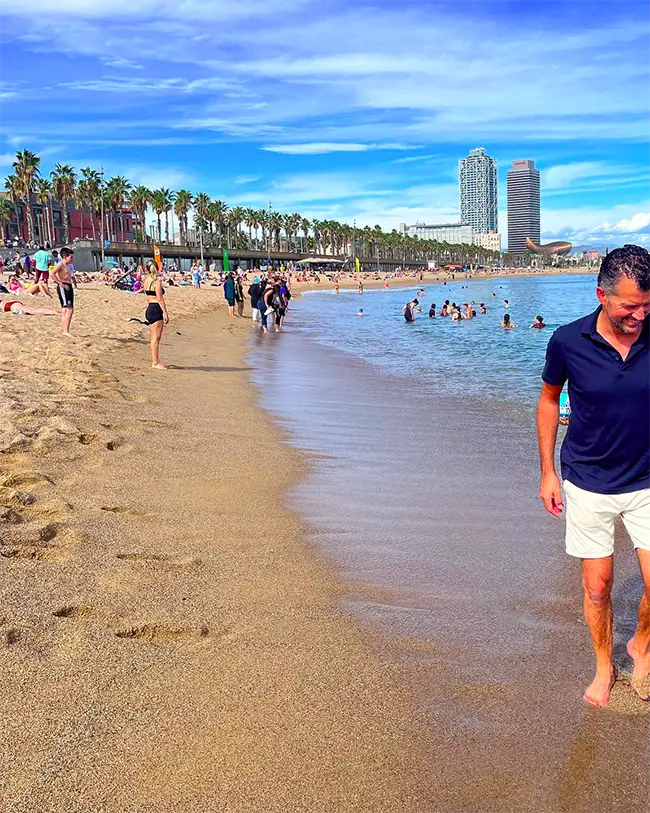
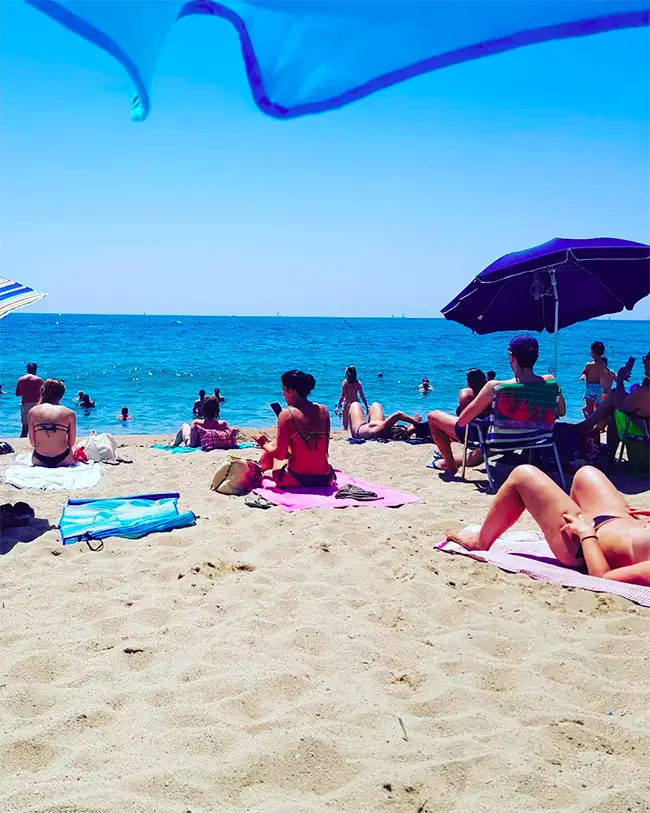
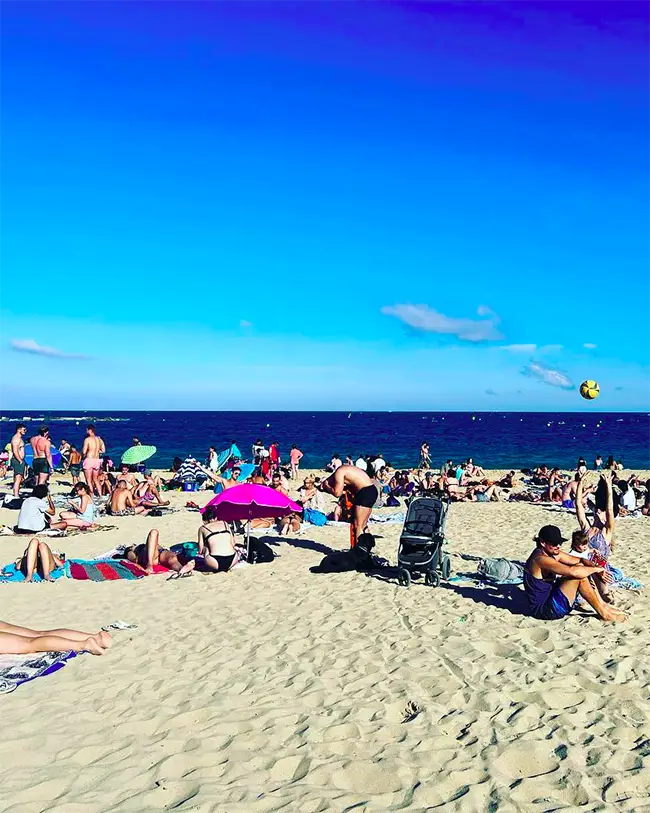
Catalonia
Although many people mistake Barcelona for the capital of Spain, that title goes to Madrid. However, Barcelona does have the honour of being the capital of Catalonia, an autonomous region of North Eastern Spain encompassing the Costa Brava, the Pyrenees mountains, and Montserrat.
The Catalonia region has its own character, culture, history and language that is quite separate from the rest of the country. In fact, the Catalan identity is so distinct that there is a powerful political movement dedicated to declaring Catalonian independence from Spain.
This journey towards independence has been challenging, however. In 2017, the government of Catalan held a referendum to vote for independence. The results of this vote were overwhelmingly in favour of separation, but the Spanish government declared the referendum illegal, and the event resulted in the arrest of several Catalan leaders.
Political debate and turmoil aside, however, the Catalan culture is fascinating. If you want to ingratiate yourself with the locals, try out a few words in Catalan or ask about the region’s unique traditions. Your interest will be much appreciated!
Civil war
If you truly want to understand Barcelona and the Catalonian people, you need to know about the Spanish Civil War. Though the war may have ended over 80 years ago, the events that transpired and their aftermath profoundly affected the city’s culture and identity.
The Civil War raged from 1936 to 1939 between the Republicans fighting to uphold the elected government and the right-leaning Nationalists fighting under General Franco. It was a violent conflict filled with suffering, bloodshed and destruction, the likes of which Europe hadn’t seen since WWI. It was ultimately won by the Nationalists, which led to Franco’s dictatorship of Spain until his death in 1975.
Barcelona played a crucial role in the Civil War. Its workers were among the first to rise up against the Nationalist rebels, and it became a revolutionary city, a Republican stronghold and a hub of anti-fascist resistance. Workers took control of factories and businesses, and anarchist militias patrolled the streets. The city’s atmosphere was electric, and people from all over the world flocked to Barcelona to join the fight against fascism.
However, this excitement and revolutionary spirit were not to last. As the years of the war passed, different factions within the Republican movement vied for power, and Barcelona suffered from internal conflict. Some of the war’s most dramatic events took place within the city, and it endured air raids in which thousands of lives were lost. Ultimately, the city fell to Franco’s forces in 1939.
If you are interested in the history of the Civil War, Barcelona’s role in it and how it shaped the city you see today, you can take a Civil War Tour. These tours take in sights of interest, including buildings that still show shrapnel scars from the air raids, memorials for those who lost their lives, political prisons, air raid shelters, and museums and book shops dedicated to stories of the war and its aftermath.
You can learn about what everyday life was like for the people of Barcelona during the war, the role of women during the conflict and how George Orwell came to write Homage to Catalonia about what he saw during his time fighting in Spain.
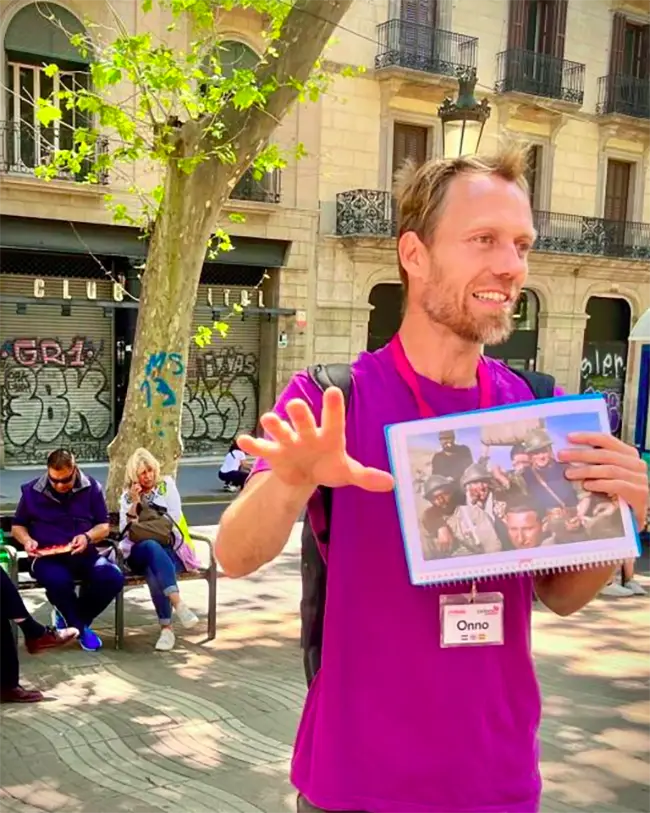
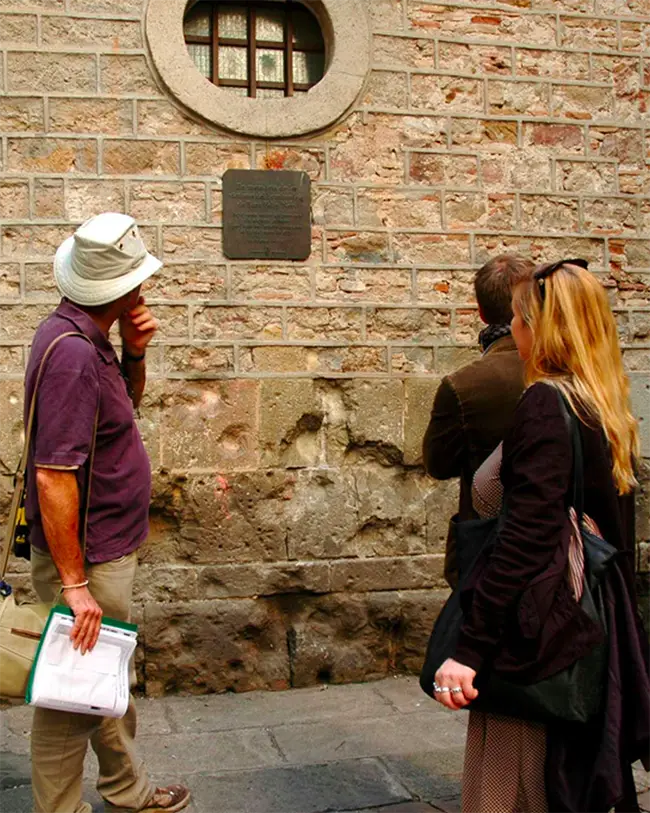
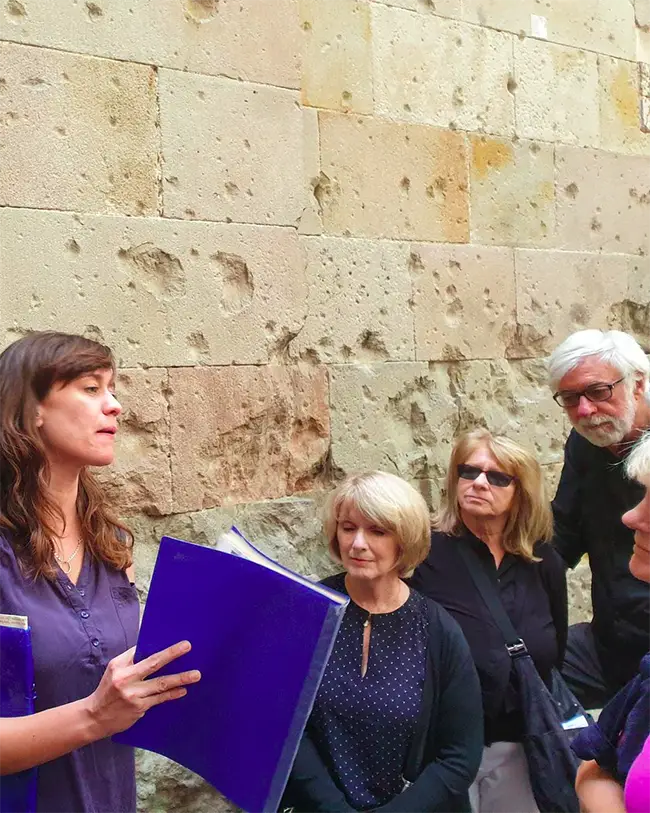
Day trips
Barcelona has so much to see and do that you might not be planning to leave the city during your trip. But you should know that the surrounding Catalonia region is equally full of amazing sights including beautiful beaches, charming villages, and breathtaking landscapes, all an easy train or car ride from Barcelona.
So you might want to see if you can squeeze in a day trip or two. If you’re tempted, here are a few great locations to consider:
- Montserrat: This dramatic mountain range is just an hour away from the city. Famous for its jagged rock formations and the Benedictine monastery of Santa Maria de Montserrat, it’s one of the most popular day trips from the city. Visitors can hike the National Park trails, enjoy the stunning landscape and panoramic views, and explore the 11th-century monastery, home to the Black Virgin, one of Spain’s most revered religious icons.
- Girona: Just over an hour by train from Barcelona, Girona was always a popular day trip destination thanks to its mediaeval old town, picturesque riverfront, excellent restaurants, and colourful buildings. But its popularity received an extra boost recently when it became a filming location for Game of Thrones. Wander this beautiful town and see if you can spot the sites from your favourite scenes.
- Costa Brava: if the crowded city beaches of Barcelona aren’t doing it for you, take a trip to one of Spain’s most spectacular stretches of coastline. Stretching from Blanes, just north of Barcelona, all the way to the French border, the Costa Brava – or ‘wild coast’ – is full of stunning beaches and picturesque towns.
- Penedès wine region: Catalonia is one of Spain’s most important regions for wine production, and the beautiful vineyards of Penedès are easily accessible from the city. Take an organised tour or travel independently by train or car and explore the many wineries. Take a cellar tour, stroll through the vineyards and sample some of the region’s famous Cava alongside a variety of excellent red and white wines.
- Tarragona: one of Spain’s most important Roman sites, this historic town is filled with well-preserved ruins. History lovers can explore the old town’s Roman walls, necropolis and the atmospheric amphitheatre which overlooks the Mediterranean. Visit the National Archaeological Museum of Tarragona to get the lowdown on what you’re looking at. And if you have time, visit the gravity-defying Aqueduct outside the city.
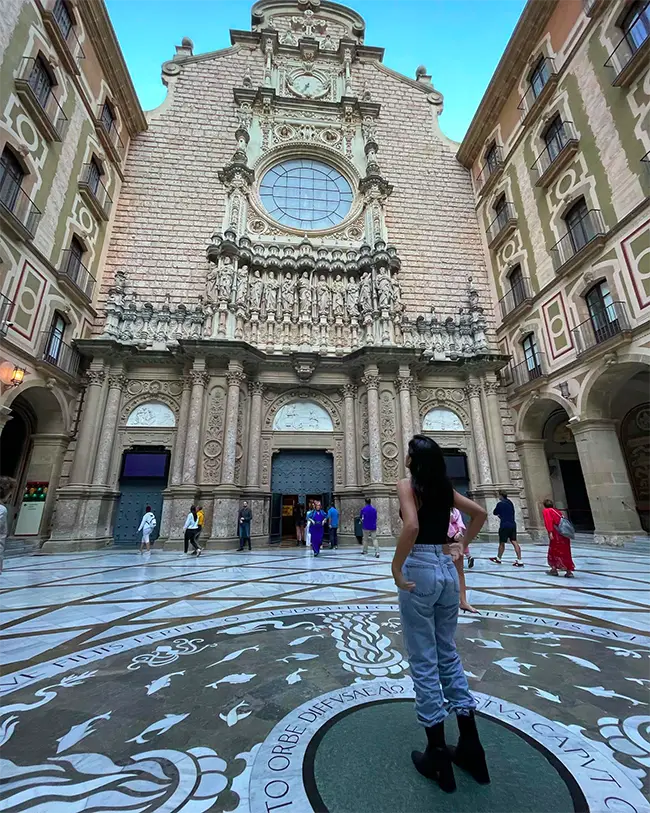


Estrella
Worked up a thirst from pounding the city’s pavements in the hot sun? Take a seat at a pavement cafe and order a frosty beer. But not just any beer, when in Barcelona, it has to be an Estrella Damm.
You won’t be in the city long before you spot the distinctive red and gold star branding of the city’s favourite beer. Brewed in Barcelona since 1876, this crisp and refreshing beer is intentionally designed to complement the city’s Mediterranean climate. It has a lighter taste than other European lagers and certainly goes down nicely in the sunshine!
And if you enjoy drinking it, why not visit the place where it’s made? While in Barcelona, you can tour the 140-year-old Estrella Damm Brewery. See how this tasty beverage is created from start to finish, and, of course, sample a few of the finished products along the way.
Salud!
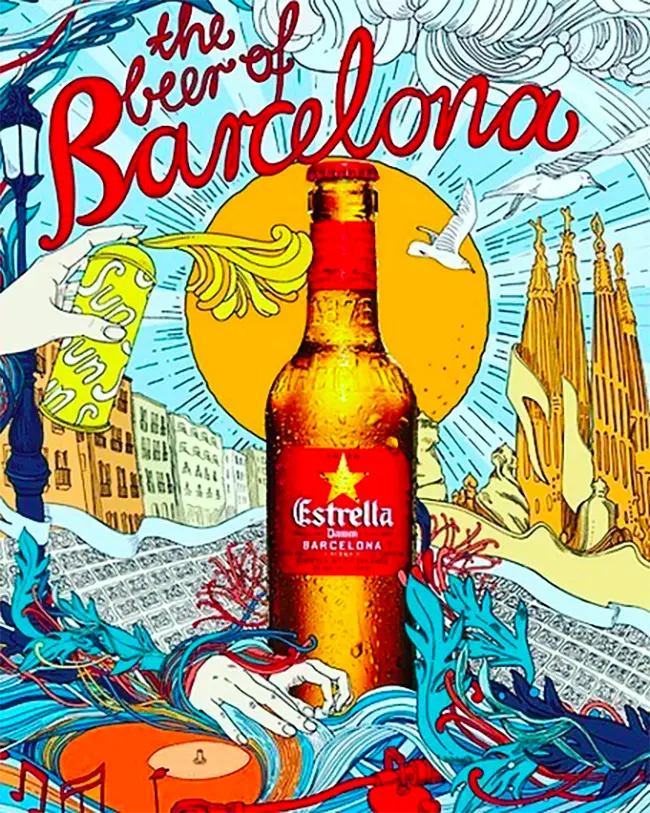
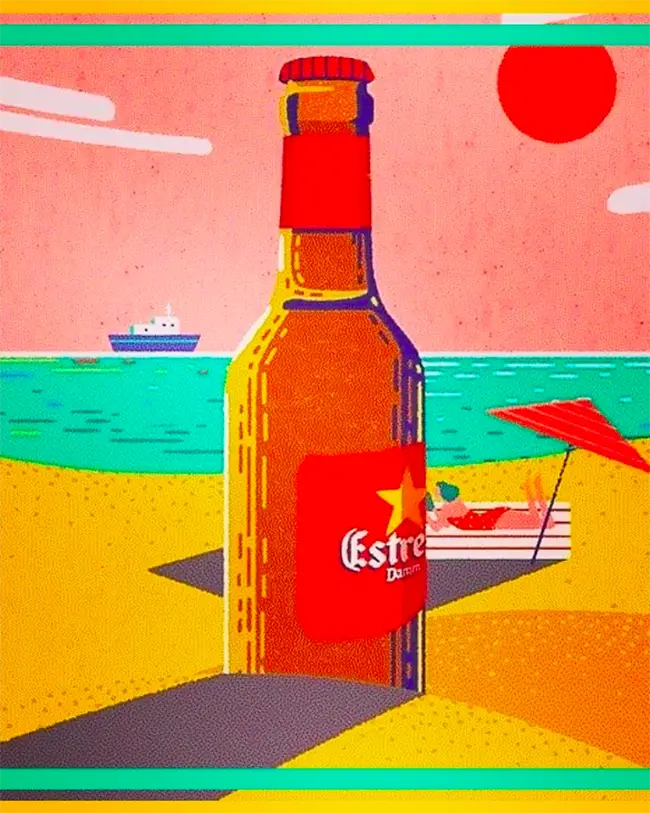
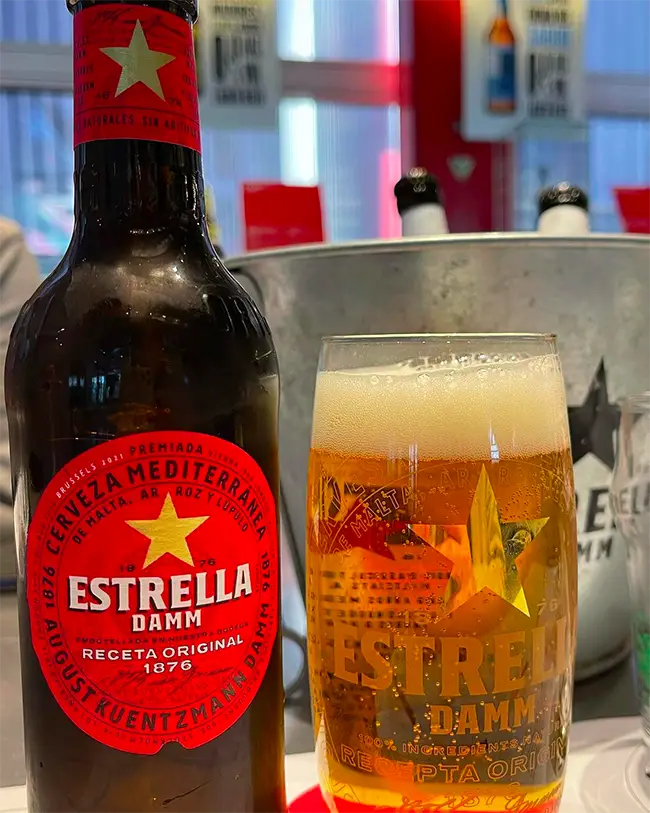
FC Barcelona
Forca Barça!
You might hear this chant echoing through the air or see it stamped on posters, souvenirs and graffiti around the city. It translates to “Come On, Barcelona!”, or “Let’s Go, Barcelona!” and refers to the city’s much-loved football team.
Barcelona FC, known simply as Barça, is one of the world’s most recognisable and successful teams and has an enormous following within the city and the wider region. Founded in 1899, this team has a long, rich history and has produced some of the world’s best players, including Lionel Messi and Xavi Hernandez.
The team is consistently at the forefront of the football world and has won numerous La Liga titles, UEFA Championships and Copa del Rey trophies. Off the pitch, the team has a strong commitment to social responsibility and is seen not just as a sports team but a symbol of Catalan pride and identity.
And it’s not just the team that is impressive. Barcelona’s stadium, known as Camp Nou, is the largest capacity football stadium in Europe and one of the largest in the world, seating over 99,000 people. It is renowned for its electric atmosphere during games and has become a pilgrimage site for international fans who visit Barcelona to tour the iconic stadium and New Barça Museum.
[Note: currently, Camp Nou is undergoing a renovation to improve its facilities even further. While the work is in progress, FC Barça plays at the Lluís Companys Olympic Stadium at Montjuïc. They are expected to stay there through the 25/26 season before returning to the newly rebranded Spotify Camp Nou Stadium. Fans can still visit the New Barça Museum, where an immersive room and virtual tour have replaced the currently unavailable elements of the old tour. Tickets also include access to the construction viewpoint.]
Visit Barcelona during any FC Barça game, and you’ll feel the excitement sweep through the city. But the intensity goes off the charts during one game, and that is El Clasico. This is the name given to the derby match whenever Barcelona meet their fiercest rivals, Real Madrid. The two teams are powerhouses of Spanish football, but their long-held rivalry goes far beyond the game itself. It has become a representation of the broader political and economic battle between Spain’s two largest cities and a symbol of Catalonia’s struggles against unified Spain.
Suffice it to say that if you want to make friends in Barcelona, show some support for the team, ask after the players and the stadium revamp and don’t mention Madrid!
Festivals
This vibrant city has a packed events calendar covering everything from religious festivals, saints days and neighbourhood fiestas to international music, independent film and Catalonian food festivals. Here are a few of the can’t-miss festivals of the year:
- Barcelona Carnival: This February festival is the Catholics’ last chance to party before the restrictions of lent arrive. And they don’t waste the opportunity! Expect colourful floats, imaginative fancy dress, and a huge parade down Avinguda del Paral·lel. The confetti and chocolate being flung from the floats make this one a winner with kids.
- Sant Jordi Festival: Did you know that Saint George is also the patron saint of Catalonia? His day is celebrated in a wonderful way, with the exchange of books and roses! Watch Las Ramblas become a colourful explosion of flower and book stalls on the day.
- Primavera Sound Festival: Each year, the Parc del Forum hosts an eclectic lineup of international bands and DJs for one of Barcelona’s biggest music festivals. The rest of the city joins in with an additional program of ticketed and occasionally free events.
- Sant Joan: Celebrate summer with this massive beach party marked by excessive drinking, bonfires and endless fireworks. It’s one of the biggest nights of the year!
- Sónar Festival: The can’t-miss event of the year for electronic music lovers.
- Pride Barcelona: See the city turn rainbow bright with a week-long diversity celebration bursting with cultural events, concerts, shows and the famous Pride Parade.
- Festival del Grec: This is the cultural festival of the summer. Its focal point is the Theatre Grec amphitheatre in Montjuïc, but its roster of dance, theatre, music and circus performances spills out across the city.
- The Gracia Festival: Each street in Barcelona’s artistic Gracia neighbourhood competes to be the most fantastically decorated in this vibrant free festival featuring street fairs and concerts.
- Festes del la Mercè is one of Europe’s biggest street parties held to celebrate the city’s patron saint. This week-long extravaganza is completely free, includes parades, concerts, and fireworks, and is a chance to see some of Catalonia’s unique cultural celebrations up close. Expect Correfoc (fire runs), Castellers (human towers), parades of gegants (giants) and Sardana dancers.
- Mercat de Mercats: This ‘market of markets’ celebrates the best in Catalan food. And since Catalan food is already exceptional, you’ll find chefs going above and beyond to create something extra special here.



Food
Foodies rejoice! Barcelona has a long history of excellent food thanks largely to the fantastic ingredients available from the fertile Catalan coastline, farmland and mountains. But it’s also home to amazing chefs who don’t shy away from innovation – this is a city with over 20 Michelin-starred restaurants!
As a result, Barcelona’s food runs the whole gamut from traditional Catalonia fare to global fusion and haute cuisine. Everyone is catered for: vegans, clean eaters, those with dietary requirements, and families with picky little eaters will all find something perfect in this city.
If you’re looking to experience authentic Catalonian cuisine and eat the way the locals do, here’s some tips for how to go about it:
Start lightly. Breakfast is not the biggest meal of the day for the locals. It’s likely to be a coffee and a pastry or toasted bread with fresh tomatoes and olive oil. If that doesn’t seem like it will get you through the morning, don’t worry; you’ll stop around 10:30am for a snack. This might involve a mini baguette sandwich or a slice of Spanish omelette made with egg, potatoes and vegetables. And, of course, more coffee.
Lunch takes place from around 1pm to 4pm and is the largest meal of the day, often involving several courses and a glass or two of wine over several hours. Order the Menu del Dia, a set, fixed-price menu that changes daily and includes wine. It’s a great, budget-friendly way to sample a selection of local dishes. You might want to head back to your hotel for a siesta afterwards!
Hopefully, your appetite is back by the evening because it’s time for one of my favourite Spanish traditions, tapas! Tapas bars are a staple of the city, relaxed, informal places where you’ll often end up standing around tall tables or barrels, chatting, drinking and enjoying the plates of tasty morsels that come with the drinks.
Tapas come in all styles as bars compete to be the most inventive, using global and experimental flavours. This can lead to some tasty results, but if you’re just visiting Barcelona, we suggest heading to traditional bars to sample classic Catalonian tapas. Try such mouthwatering dishes as stuffed olives, anchovies in vinegar, meatballs in tomato sauce, marinated squid, grilled garlic prawns, wild mushrooms, roasted red peppers, chorizo or Bombas Catalana, a potato croquette with a ground beef filling.
There is no real end to tapas time, and many Barcelonins will forgo dinner to continue tapas bar hopping. Those who do switch gears and opt for a sit-down dinner will find it’s a lighter meal than lunchtime, although still one to linger over with plenty of wine.
Dinner happens late in Barcelona. Many restaurants don’t begin serving till after 8pm, and it’s not unusual to go out for dinner at 10pm. Look for restaurants showcasing Classic Catalonian fare, characterised by abundant seafood and game, rich, hearty meals made with exquisite local ingredients.
Some local dishes to try are:
- Arròs Negre: Rice cooked in black squid ink.
- Arroz a la Catalonia: A Catalonian version of Paella cooked without the saffron.
- Mandonguilles Amb Sipia: Catalan’s answer to a surf and turf – meatballs and cuttlefish in a thick gravy.
- Fideuà: A paella-esque dish with noodles instead of rice, infused with garlic and olive oil.
- Bacalla salat: Aalt cod often served shredded in a salad with fresh tomatoes, onions and black olives.
- Calcots: A cross between a leek and an onion. These are roasted on an open fire and served with a romesco dipping sauce. These are so messy to eat that you’ll often be presented with a bib and gloves when you order them!
And if you have any room left after all that, why not try a traditional dessert? Some local cheese drizzled with honey or Crema Catalana, the local version of Creme brulee.
Enjoy! Or, as the Catalonians say, Bon profit!
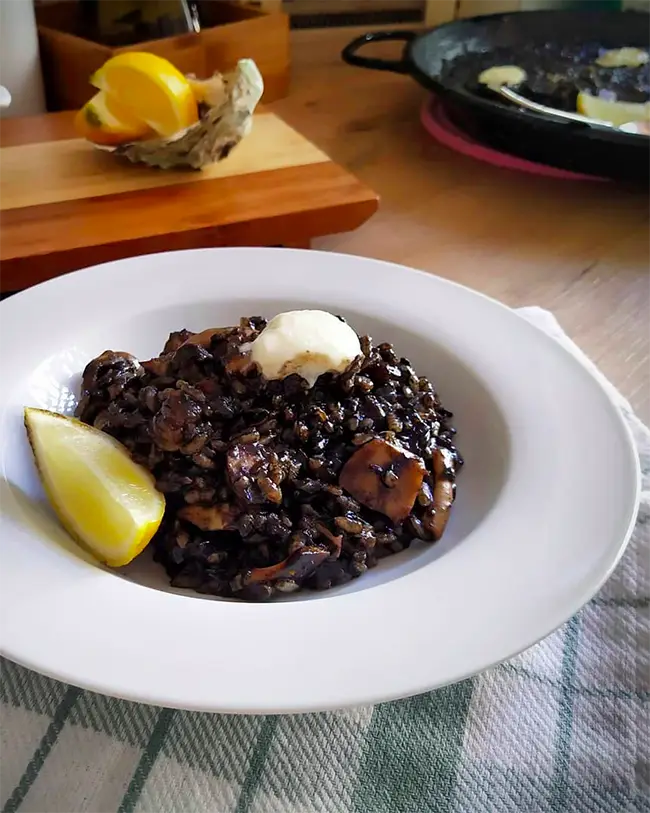
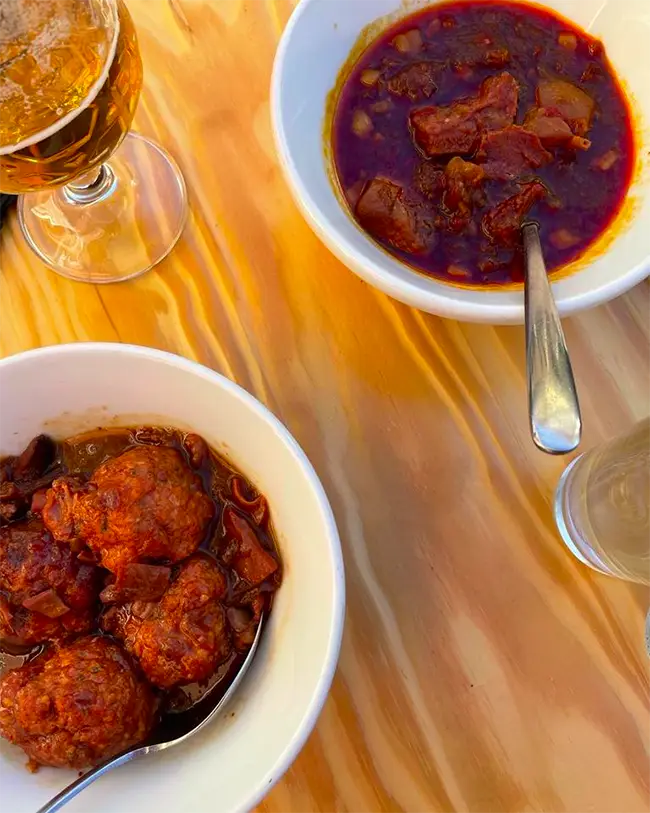

Gaudi
Antoni Gaudi is one of Barcelona’s most famous names and a pioneering force in the world of architecture. The Catalan-born designer lived much of his life in Barcelona, and his work has come to be a defining feature of the city.
A visionary artist, Gaudi’s work embodies a blend of many architectural styles, including Gothic, Art Nouveau and Catalan Modernism. He was also influenced by his love of the Catalan region, devout catholic beliefs, and fascination with the natural world. This combination of influences led to his unique, intricate creations, which tend to be colourful, whimsical, and fantastic.
Gaudi’s work can be seen throughout the city and is a key reason many people visit. Some of his most famous buildings are:
- Casa Vicens: A house in the Gracia district, considered to be Gaudi’s first work within the city.
- Casa Milà: Now more commonly known as La Pedrera, or The Quarry, because of its rough-hewn facade. This strange undulating building is known for its fantastic rooftop and intricately decorated interior.
- Casa Batlló: A residential building that looks like something out of a fairy tale. This building is filled with natural elements and imagery, and its surreal interior is a masterpiece in the use of light to create atmosphere.
- Park Güell: One of the most iconic spaces in Barcelona, this is an enchanting place to wander and admire the curving mosaic-covered walls, fountains, and statues that seem to have stepped right out of Gaudi’s imagination.
- Palau Güell: one of his more understated works, this palace built for his patron Eusebi Güell, is still a riot of architectural styles. And it has a fascinating history.
- And, of course, La Sagrada Família: Gaudí’s most famous work, this basilica is considered his masterpiece. Construction began on this vast project in 1882 and continues today. Yet despite its unfinished state, it remains Barcelona’s most famous sight, attracting millions of tourists who come to marvel at the soaring spires, intricate facades, and innovative structure.
This list is just a fraction of his repertoire. Some of his earlier works, like the Bellesguard Tower, Güell Pavilions, and other lesser-known works are definitely worth checking out.
Gaudi died unexpectedly in 1926, when he was knocked down by a tram while on the way to the Sagrada Família construction site. But, despite his death almost 100 years ago, his legacy remains powerful, drawing art and architecture lovers to visit his work and inspiring new generations of designers. Since 1984, seven of Gaudi’s works have been designated as UNESCO World Heritage Sites in honour of his impact on the world of architecture and the city of Barcelona.
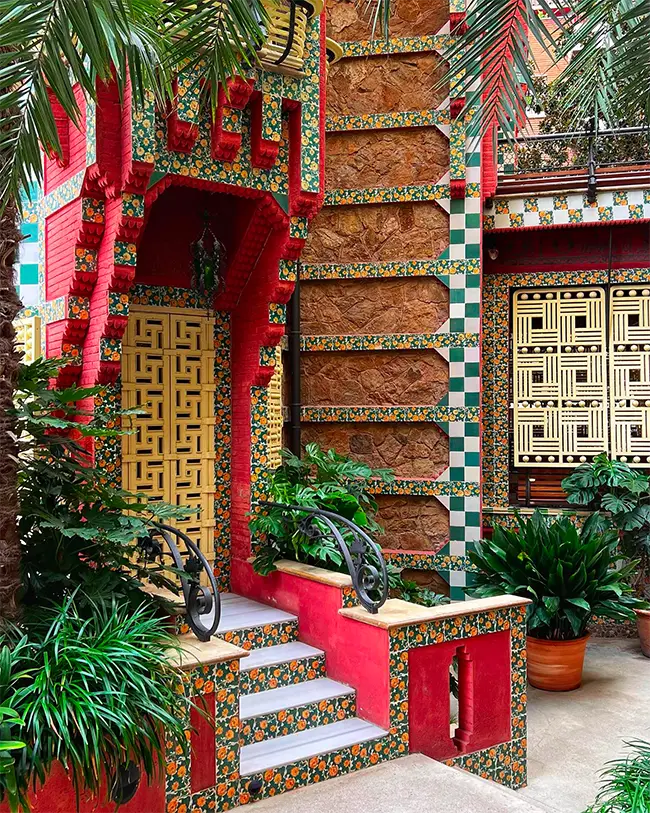
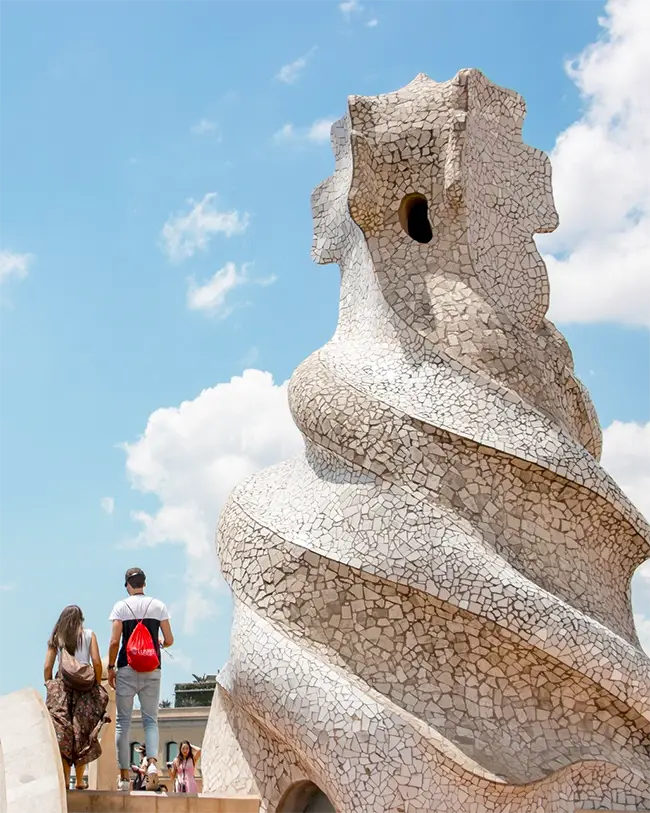
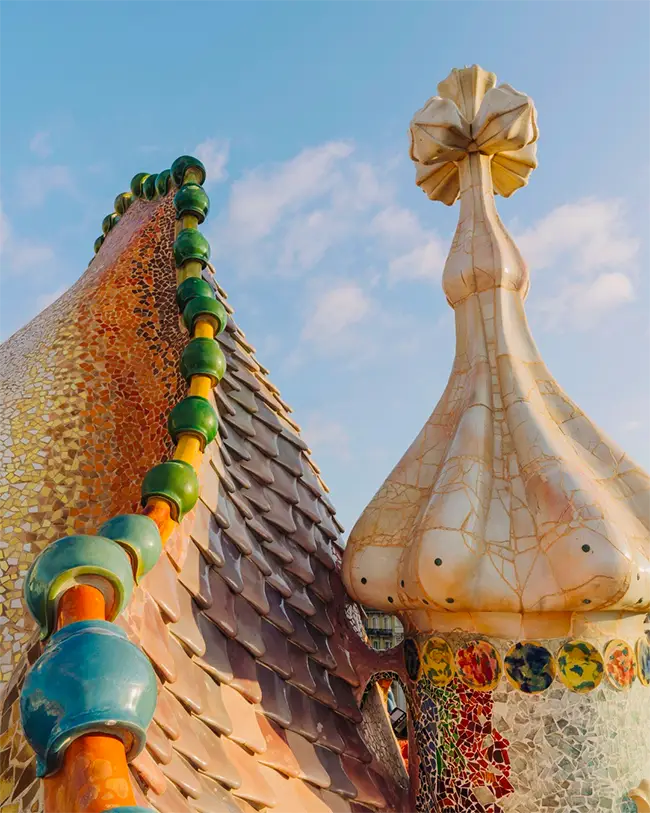
Hilltops
Tired of the confines of the city? Want to rise above the urban sprawl and breathe fresh mountain air while enjoying glorious views? Well, you’re in luck; Barcelona has not one but two elevated escapes well worth exploring.
The first is Montjuïc, a prominent hill standing at 173m above the sea overlooking the Barcelona harbour. This scenic wooded rise has a fascinating history and has undergone several transformations over the years to become an important part of Barcelona’s identity and a wonderful place to escape the city.
Originally used as a defensive post for the city, the castle-topped Montjuïc saw massive changes ahead of the 1929 Barcelona International Exposition. The World Fair coming to town led to the creation of numerous cultural sights and incredible buildings at Montjuïc.
It was then transformed a second time ahead of the 1992 Olympic Games which saw the creation of world-class sports and recreation facilities. Plus the renovation of the Olympic Stadium – currently the home of FC Barcelona until the renovations on their stadium, Camp Nou, are complete.
Visitors can explore Montjuïc Castle, a 17th-century military fortress with an eerie history, catch an event at the Theatre Grec amphitheatre, or wander the grounds of the Botanic Gardens. Art lovers can explore The Museu Nacional d’Art de Catalunya (MNAC), which holds the largest collection of Catalan art in the world, or the Fundació Joan Miró, dedicated to the works of the surrealist artist. And everyone should stick around to watch the Magic Fountain’s spectacular light and music show each evening.
Montjuïc is known for its spectacular views of the city, port and coastline, wonderful green spaces, and myriad attractions that will appeal to all tastes, from history hunters to art enthusiasts, sports fans and nature lovers. This hilltop spot is a must-visit destination for anyone exploring Barcelona.
The second elevation is Mount Tibidabo to the northwest of the city. Standing at over 500m above sea level, it is the highest peak in the Collserola mountain range. Tibidabo is a popular destination for tourists and locals alike thanks to its range of natural and man-made attractions and breathtaking panoramic views of the city and sea.
Take a public bus or board the Funicular Railway to be transported to the top of this forest-covered mountain. Once there, you can visit the stunning Iglesia del Sagrat Cor, the impressive Neo-Gothic church perched atop the mountain. Be sure to visit the observation deck for spectacular views of the city and coast!
Alternatively, you can spend the day at Tibidabo’s old-fashioned amusement park, complete with vintage fairground rides, modern roller coasters and playgrounds. Or explore the 8,000-hectare park, ideal for hiking and taking a well earned break from the city.
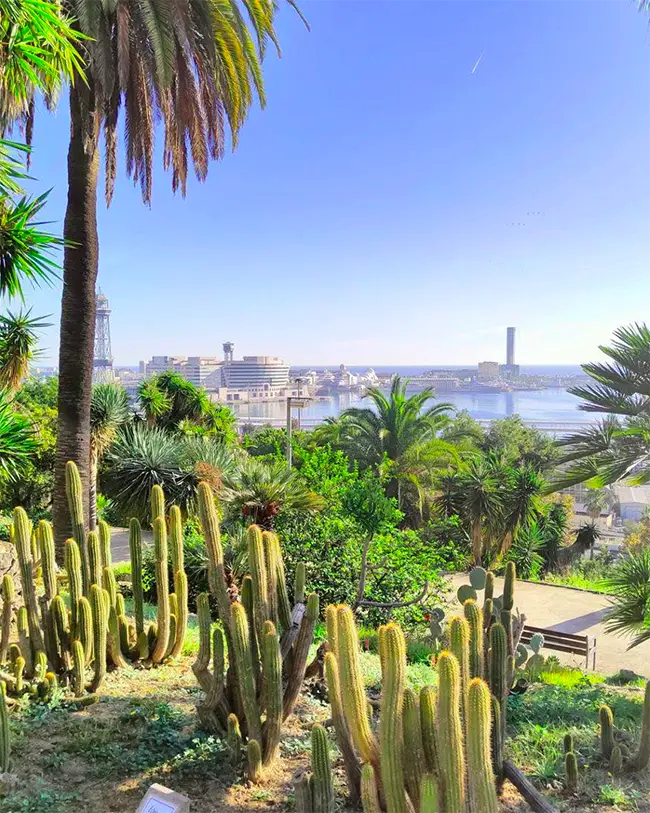
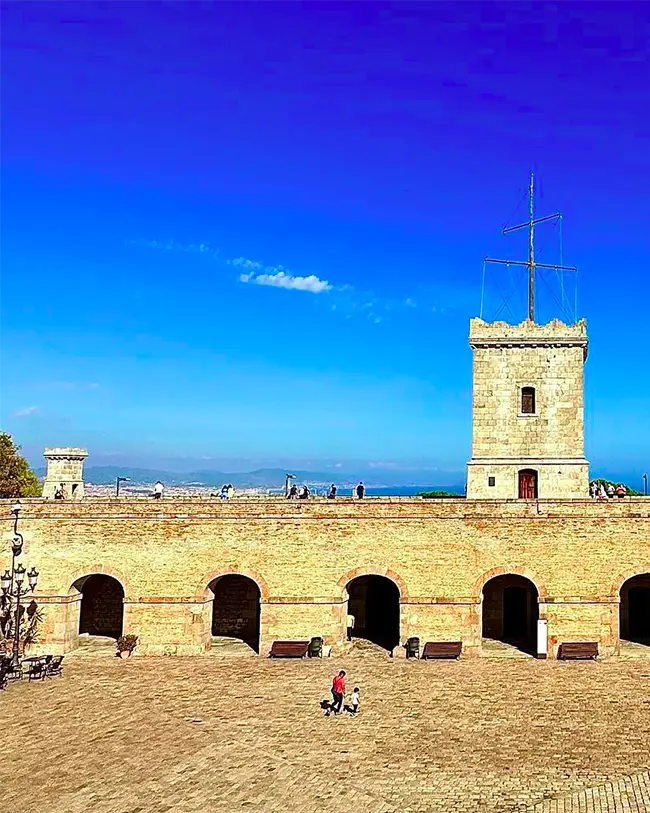
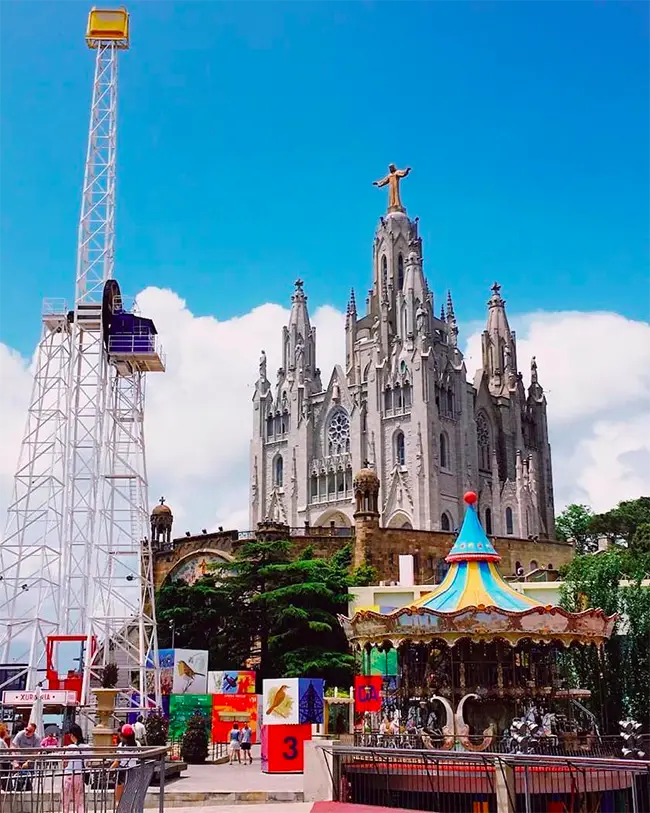
Illa de la Discòrdia
The Illa de la Discòrdia is a fascinating collection of buildings on Passeig de Gràcia in the Eixample district. The area features work by Barcelona’s most famous architects, all standing side by side to create a visually stunning architectural exhibit. The striking and contrasting design styles of the five buildings are fantastic and led to the nickname, ‘the block of discord’.
The five buildings are:
- Casa Batlló by Antoni Gaudí: The most famous of the five buildings renowned for its undulating façade, vibrant colours and whimsical design.
- Casa Amatller by Josep Puig i Cadafalch: An innovative blend of traditional Catalan and contemporary architectural styles. This artist’s most well-known building in the city is instantly recognisable by its distinctive ceramic tiled facade.
- Casa Bonet by Marceliano Coquillat: Created by one of the lesser-known architects on the block, this one has one of the simpler facades but contains beautiful neo-baroque details and wrought iron balconies.
- Casa Mulleras by Enric Sagnier: It is the only building in a neoclassical style, and the classical, straight lines contrast magnificently with the neighbouring buildings.
- Casa Lleó Morera by Lluís Domènech i Montaner: This elegant building has elaborate Art Nouveau ornamentation and is unique for the way it curves around the corner of the block.
The Illa de la Discòrdia offers a visual feast of some of Barcelona’s most iconic architectural treasures. But the appeal goes beyond the aesthetic. The contrasting styles invite you to delve deeper into the stories behind these buildings and the innovative (and sometimes competitive) visionaries behind their creation.
It’s a must-visit spot for anyone looking to unravel the layers of Barcelona’s architectural history. And it doesn’t hurt that the placement makes them ever so convenient to view in one go!
Josep Puig i Cadafalch
No tour of Barcelona’s architecture is complete without mention of Josep Puig i Cadafalch. The visionary Catalan-born architect was a disciple of the Catalan Modernism movement (among other styles) and contributed several masterpieces to the city and surrounding area.
His notable works include the visually satisfying Casa Amatller on the must-visit Illa de la Discordia. This magnificent building showcases the careful integration of traditional Catalan design with contemporary architectural techniques. He also created Casa Martí, also known as “Els Quatre Gats”, a faux-mediaeval mansion which became a famous meeting place for modernist artists.
Outside the city, he worked on the renowned monastery of Sant Benet in Montserrat and the modernista headquarters and wine cellar of the Codorniu winery – a fantastic place to admire architecture while sampling the region’s famous Cava.
But Josep Puig i Cadafalch contributions to this city go beyond architecture. He was also an art historian, politician and passionate supporter of the Catalan region and culture. He stood as a city councillor, a member of the Spanish parliament and president of the short lived Commonwealth of Catalonia.
During his time in office, he supported the promotion of Catalonian culture, language and art, as well as setting up science, education, and healthcare institutions and improving city and rural infrastructure in the region. It’s safe to say his legacy will continue in Catalonia for many years to come.
Kids
Barcelona has long been a popular destination for families for many reasons. The city is chock full of activities for children of all ages, the food is varied enough to appeal to all pallets, the climate makes it pleasant to be outside exploring, and the shops and pharmacies are well stocked with everything you could need. What else could you want? How about Mediterranean hospitality that means children are welcome everywhere?
In Barcelona, you’ll notice that the locals regularly take their children out to dinner because eating is a family experience. So feel free to do the same. Older kids will enjoy being included in adult dinners, while young kids will get a kick out of staying up late and being made a fuss of by the locals.
When it comes to your itinerary, Barcelona’s unique landscape, with beaches alongside the city centre, means you can really mix up the activities on your holiday, and kids never get a chance to get bored.
The beautiful golden sand beaches let your kids build sandcastles, paddle, swim, try water sports, and play volleyball. Why not rent bikes and cycle along the promenades, stopping at each beach for a swim or an ice cream?
Then, stroll down La Rambla, enjoying the street performers and human statues and indulging in churros from street vendors. Hit some of Barcelona’s fantastic parks, such as Parc de la Ciutadella, where you can relax, picnic, enjoy the playground, and take a boat out on the pond. Head to the top of Tibidabo Hill to the Parc d’Atraccions, an old-fashioned funfair with some thoroughly modern thrill rides. Or take the cable car up to Montjuïc to watch the Magic Fountain in action, a display guaranteed to delight young and old alike.
If you want to immerse your kids in some culture, take them on a tour of Gaudi’s buildings. The fantastic designs will delight children, spark their imaginations and change the way they think of architecture. Squeeze in a museum or two, such as the Cosmo Caixa interactive science museum, the fascinating MIBA Museum of Inventions and Ideas, or the open-air Poble Espanyol, where you can explore replicas of 117 buildings from all over Spain. Or how about the Museu de la Xocolata, because who doesn’t love a chocolate museum? Pair that with a visit to Papabubble, an artisanal sweet shop in the Gothic Quarter, where you can watch the sweets being made before feasting on the unique treats.
Animal lovers should head to the Barcelona Zoo, where you can see everything from geckos to goats to gorillas. Or take a trip to the fantastic Barcelona Aquarium, one of the largest in Europe, and walk through glass tunnels while sharks and manta rays swim overhead.
In short, no matter the age of your crowd or their tastes, you’ll find plenty to amuse everyone in Barcelona.
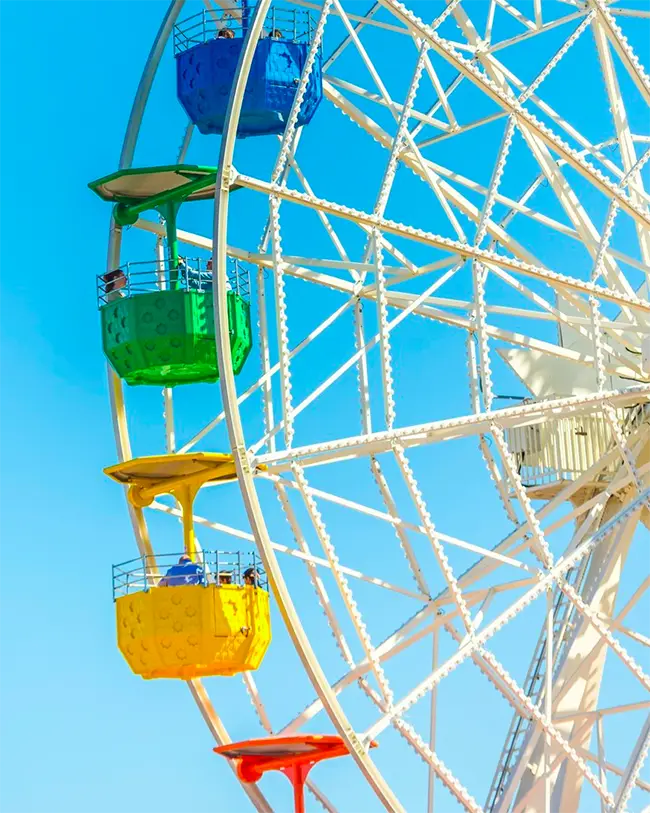
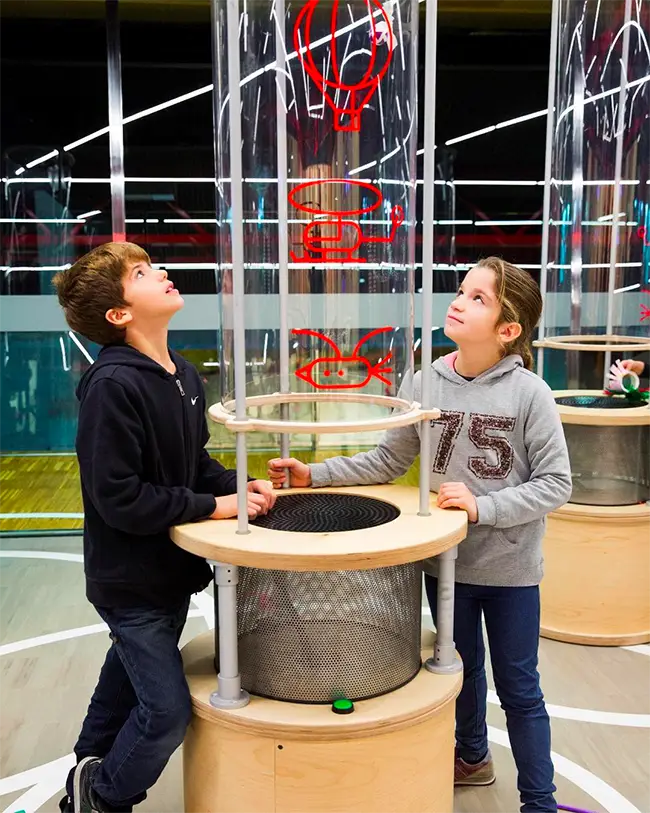

LGBTQ+
Barcelona is one of Europe’s most inclusive and welcoming cities for LGBTQ+ travellers. This open-minded metropolis has a vibrant social scene and many attractions catering for the LGBTQ+ community. This is due in no small part to the incredible collection of organisations and advocacy groups who work hard within the city to create safe spaces, offer support and fight discrimination at home and abroad.
The city has abundant gay bars, diverse clubs, drag nights, cabarets, and even lesbian bars which are often noticeably absent from many gay districts. The scene’s focal point is in Eixample or Gaixample as the area is known locally, but you’ll also find gay clubs and bars in the El Raval neighbourhood and along the bohemian Paral·lel Avenue.
But, in addition to all the bars and clubs, Barcelona also celebrates diversity in the daylight. You can visit the gay-friendly nudist areas of San Sebastian and Mar Bella beaches, visit LGBTQ+ bookshops and cafes, stay in inclusive hotels and take a steam in a gay-freindly sauna.

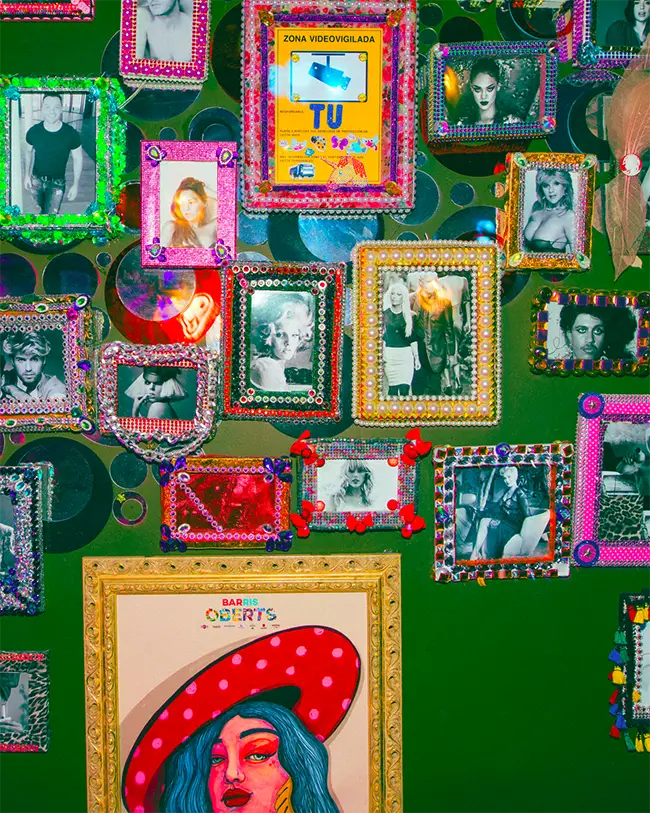

Barcelona also has a diverse festival schedule including, of course, the city’s incredible Pride celebrations, but also lesbian and gay film festivals, The Circuit – gay festival week, The Girlie Circuit – Barcelona’s lesbian festival, and Panteresports – an annual international multi-sport tournament for the LGBTQ+ athletes.
In short, no matter your identity or orientation, you’ll find Barcelona to be a welcoming and action-packed holiday destination. But if you fancy a change, don’t worry, it’s just a short journey to the neighbouring town of Sitges, the LGBTQ+ capital of Catalonia!
Markets
The markets of Barcelona are an institution and a fantastic place to wander and soak up the sights, sounds, smells and tastes of the city. And they’re not just for the foodies. Barcelona’s markets cover the full spectrum of wares, including crafts, antiques, curios, fabric, art, vintage clothes, books and collectables. Check out some of these top shopping spots:
- Mercat de la Boqueria is Barcelona’s most famous – and one of Europe’s largest – food markets. Conveniently located right off Las Ramblas, this place is a bustling hive of fresh produce, smoked meats and cheeses, seafood, baked goods and even offal shops. Best of all is the collection of tapas bars and food stalls where you can sample all manner of local delicacies.
- Mercat de Santa Caterina is a diverse array of food stalls, bars and cafes in an architectural gem of a building renowned for its fantastic multicoloured ceramic roof.
- Mercat de Sant Antoni is one of Barcelona’s oldest markets. It attracts more locals than tourists who shop for produce throughout the week and books, clothing, and antiques at the Sunday Book Market.
- Mercat del Encants is also known as Mercat Fira de Bellcaire, and this famous flea market has been around for over 800 years. Over 500 stalls are arranged beneath a dramatic reflective roof, selling everything from complete trash to hidden treasure. Go early on Monday, Wednesday and Thursday to see the antiques auction and hang around afterwards to pick up an unsold gem at a knockdown price.
- Mercadillo de la Plaça Sant Josep is a fantastic little market for art lovers. Local Catalan artists gather beside the church in Plaça de Sant Josep Oriol every weekend to display and sell their work. It’s a wonderful place to chat with local artists and pick up some authentic Catalonian art.
Whether you want to shop, eat, browse, or people-watch, Barcelona’s markets are a fantastic place to spend a few hours soaking up the atmosphere.
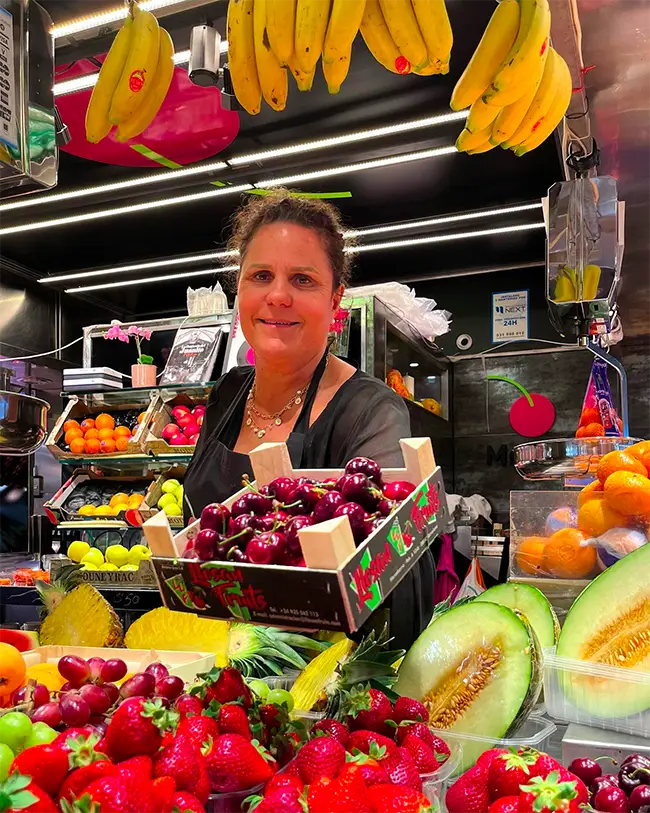
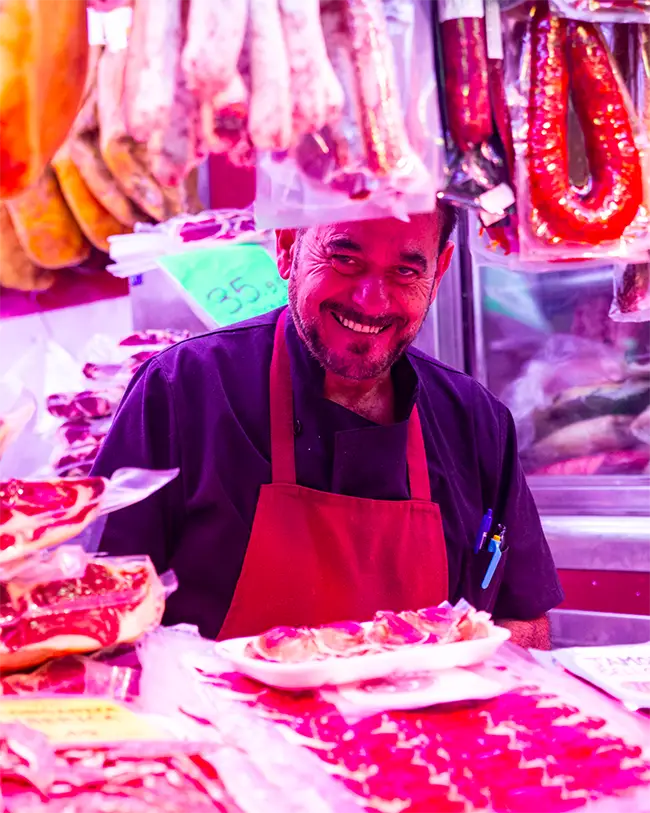
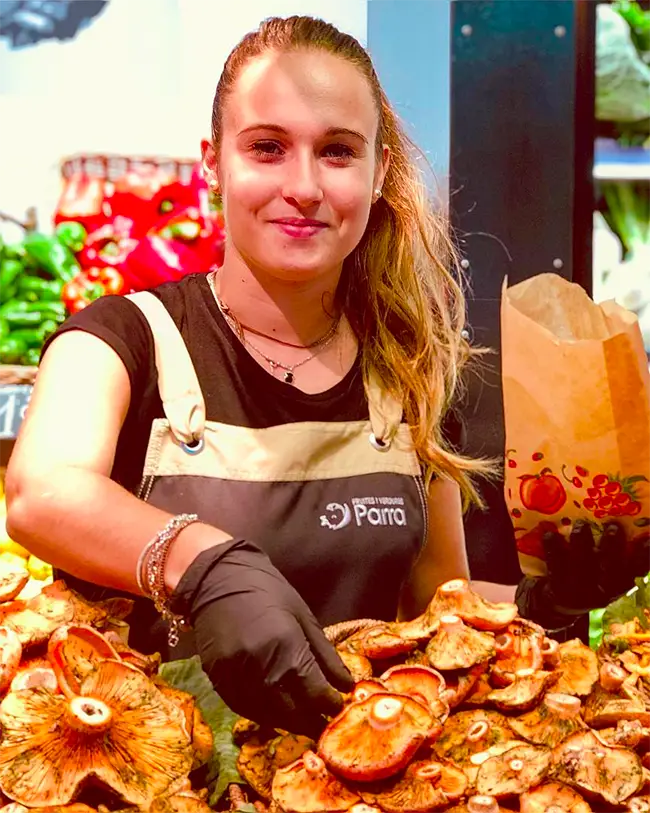
Neighbourhoods
One of the many things to love about Barcelona is that there’s a neighbourhood – or barrio – for all tastes. And they’re all easily explorable and well connected! Here are some of our favourite spots to visit, stay in and explore:
- Barceloneta, the city’s popular waterfront district, was once a fishing village before becoming a working-class, industrial neighbourhood as the city’s port grew busier. Then came the Olympic renovations in the 80s and 90s, and the area was transformed by the creation of beaches and waterfront promenades lined with tapas, restaurants and bars. Now, it’s the top place to stay for beachfront accommodation and nightlife.
- Gracia was once a separate town from Barcelona and retains its individual character despite now being surrounded by the city. It’s a bohemian area filled with vibrant plazas filled with busy markets in the morning and pavement cafes and tapas bars in the evening. It’s the place to find global cuisine, international boutiques, art galleries, creative spaces, and up-market cocktail bars.
- Poblenou, once a somewhat functional and unloved neighbourhood, this area was transformed by the creation of the Olympic Village and is now one of the city’s trendiest neighbourhoods. The northern end has become a constantly evolving hub of warehouse projects, tech startups, co-working spaces, independent galleries, craft beer breweries and some truly excellent brunch spots.
- The Gothic Quarter is a must-visit for all travellers to Barcelona. This district is the historic heart of the city, and you can lose pleasant hours wandering the labyrinthine streets gazing at the oldest buildings in the city, stumbling upon ancient plazas, stopping for coffee in atmospheric cafes and browsing in centuries-old shops. It’s also home to surprisingly good nightlife and late-night venues.
- L’Eixample was created when Barcelona needed more space outside of its walled Gothic Quarter. This modern gridded district is easy to navigate and well connected with the rest of the city. It’s a stylish, elegant district split in two by the famous Passeig de Gràcia, Barcelona’s most luxurious avenue, home to some of the city’s most upmarket shops and designer names. L’Eixample is also home to several of Gaudi’s best-known works, including the Sagrada Familia. And, despite its luxurious shopping and exceptional architecture, this is one of the most popular neighbourhoods for accommodation.
- There’s also edgy Poble-sec with its easy access to Montjuïc.
- El Born with its fine dining, fascinating architecture and eclectic concept stores.
- And multicultural El Raval, working hard to shake off its seedy reputation and emerge as the new hip artistic district complete with bustling markets and cool nightlife.
In fact, there are just too many to list here. You’re going to have to visit for yourself and find your favourite neighbourhood!
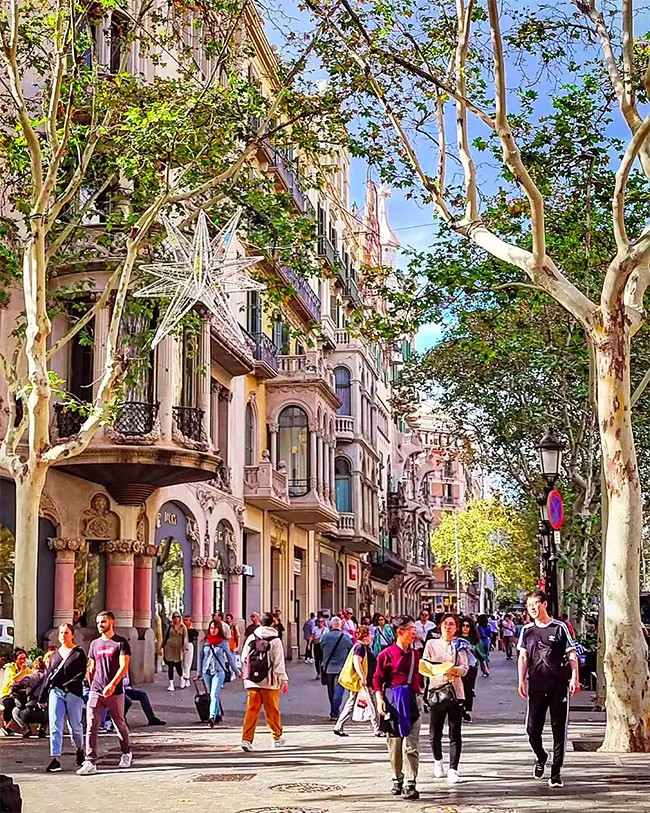
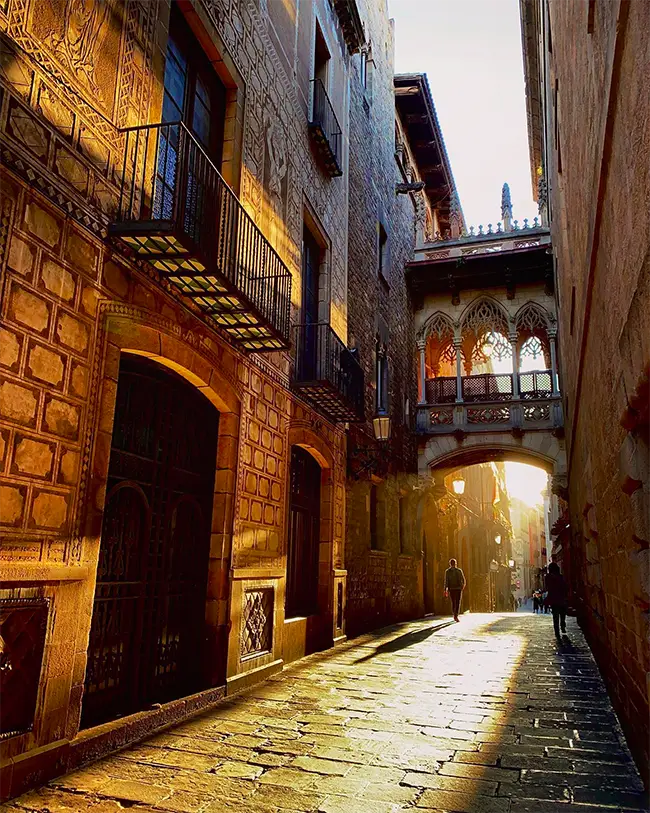
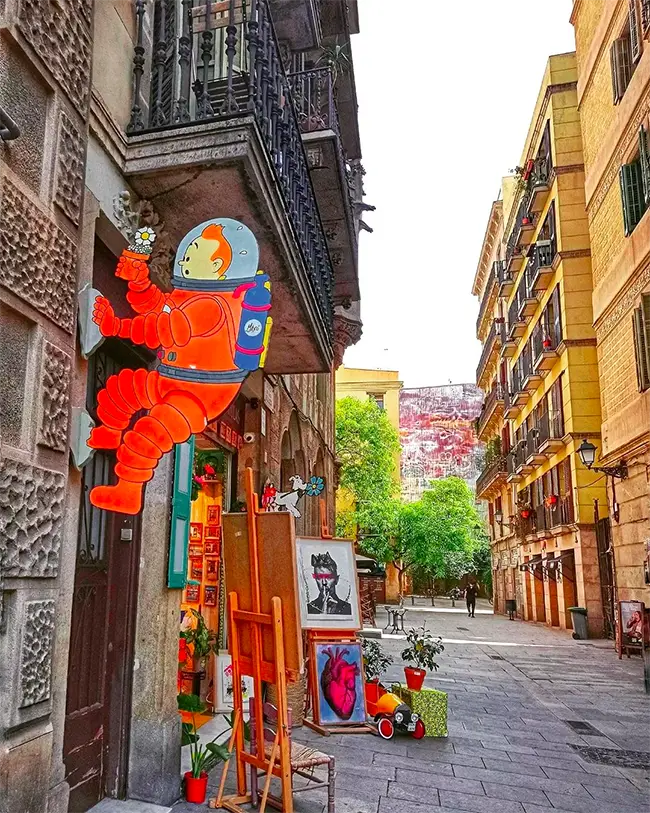
Nightlife
When you think of Spanish nightlife, it might be the Balearic Islands of Mallorca and Ibiza that spring to mind. But trust us when we say Barcelona can hold its own when it comes to partying. This city’s eclectic mix of neighbourhoods means a broad range of nightlife is available for all tastes. From beachfront beers to swanky cocktail lounges to super clubs, this city has it all.
Las Ramblas makes a great starting point where you can grab a few cheap cocktails while watching the street performers in action. Hit up Plaza Real to start your night with dinner and a flamenco show, then make your way into the Gothic Quarter to bar hop between quirky hole-in-the-wall dives and tourist-filled British and Irish Pubs.
If you like your bars a little cooler, head to the trendy district of El Born or edgier Raval to hang with a hipper crowd while still being part of the atmospheric old town. Bohemian Gracia is a little further out, but it’s the place to go if you want authentic Catalan venues and a much more local vibe. Modern L’Eixample is where to go for the LGBTQ+ district and funky cocktail lounges that make great pre-club venues.
If your style is more relaxed, head to Barceloneta, where you can kick back with a beer and live music in the string of beachfront chiringuitos at sunset. For something a little different, hop on a boat and take a party cruise around the Barcelona waterfront before returning to Port Olimpic to kick the night up a gear. The sophisticated port area is the place to be for upmarket cocktail lounges, cool clubs and beautiful people. Hit the dancefloor in one of the neon-lit clubs, and if you’re still going past 3am, it’s time to make your way to Barcelona’s biggest clubs, Pacha and Opium, where the party keeps going until dawn. The Hotel Arts Barcelona makes a perfect luxury spot to catch up on sleep between clubbing sessions.
Barcelona’s nightlife is an electric mix of traditional and modern, and its diverse range of venues and vibes ensure an unforgettable night whatever your tastes.
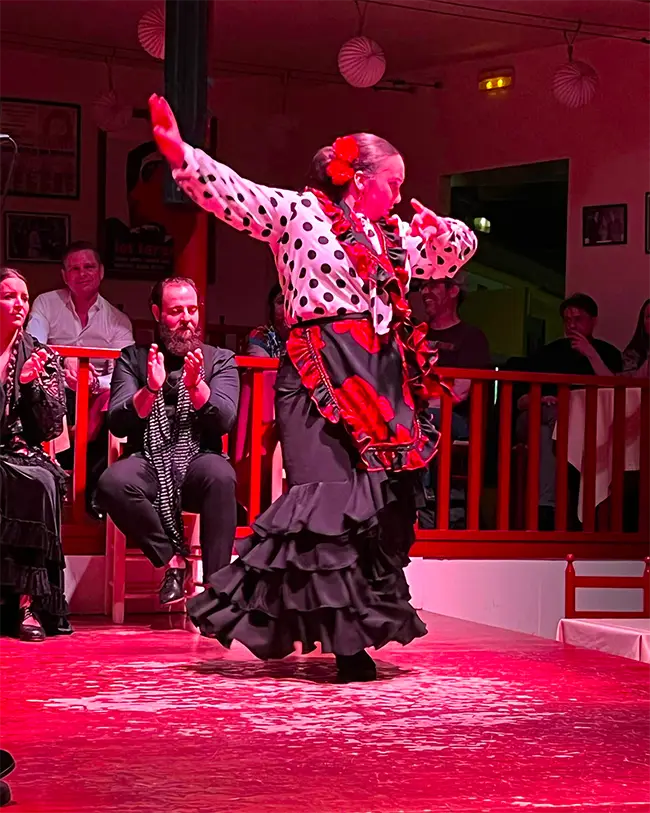
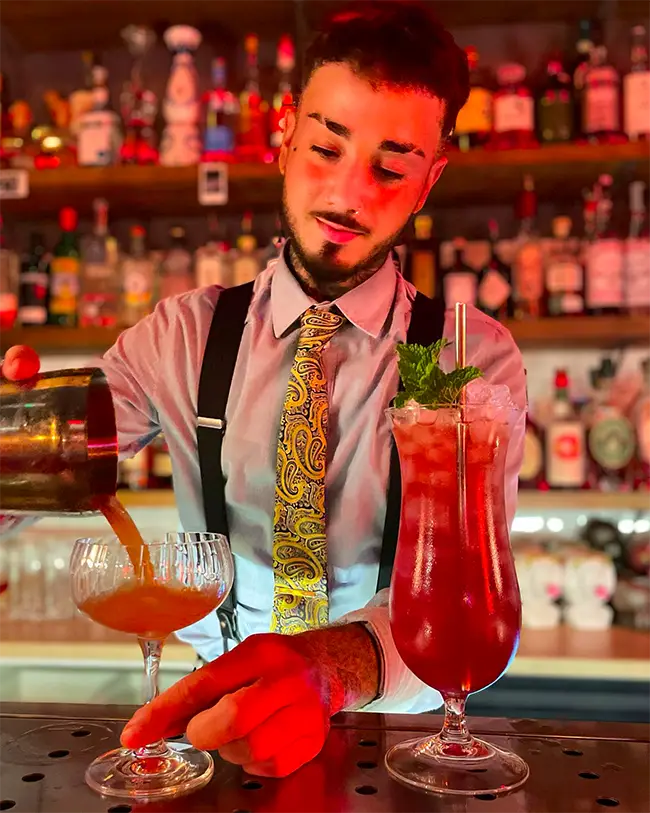
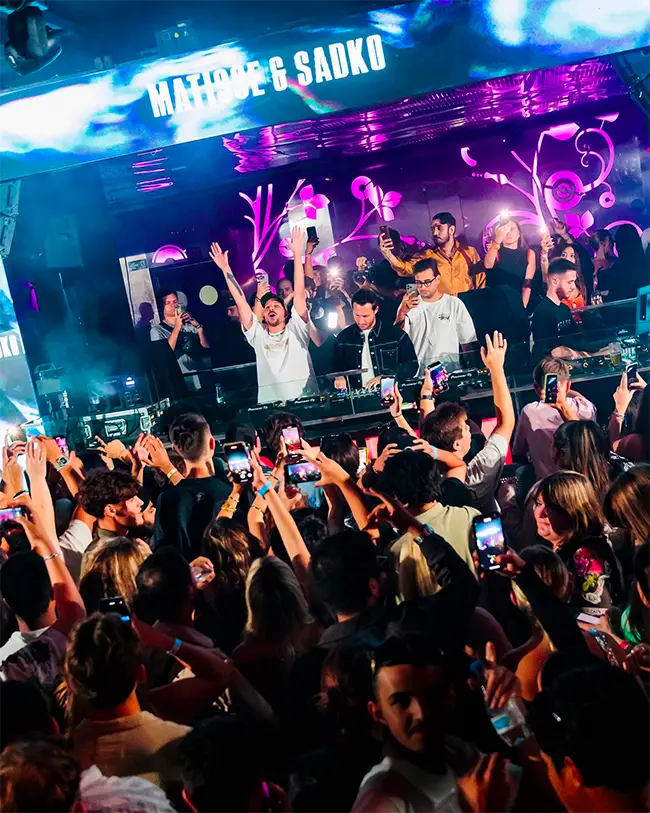
Olympic Games
Barcelona! Such a beautiful horizon!
Remember the Barcelona Olympics in 1992? I do, mainly for that iconic theme song written and belted out by Freddie Mercury. But that wasn’t the only notable event associated with the Olympics.
The 1992 games changed the shape of Barcelona and utterly revamped its identity on the world stage. So much so that Barcelona is often held up as an example to other host cities of how the Olympics can be used to rejuvenate cities, adding value that lasts long past the closing ceremony.
The city used their Olympic funds and momentum wisely, effecting major changes in the city’s infrastructure. They improved public transport systems, road networks, and telecommunications. They created new accommodation, facilities, parks, gardens and recreation spaces. And, of course, they built and improved the city’s sporting venues and stadiums, such as the Palau Sant Jordi, now one of Spain’s most significant sports and live music venues.
One of the most notable changes was the transformation of Barcelona’s waterfront. Before the Olympics, there were no beaches in the city, just a rather industrial waterfront. But, in order to provide visitors with a place to relax and enjoy the sea, a 2-mile stretch of coastline was cleaned up, tons of sand were brought in, and Barcelona’s iconic city beaches and Passeig Marítim promenade were built. This effectively transformed a once-overlooked neighbourhood into a hub of leisure and relaxation that is now a focal point of the city.
The waterfront was not the only area to be transformed. Montjuïc received a stadium renovation and beautiful new green spaces, while the creation of the Olympic Village entirely revamped Poblenou and turned it into one of Barcelona’s coolest neighbourhoods.
These changes led to highly successful games and improved the ongoing quality of life for the city’s residents. But the Olympic Games revamp was also the catalyst for Barcelona’s tourist boom.
The newly famous and accessible city began attracting visitors in previously unseen numbers. And with the tourists came an influx of money, catapulting the city into a new and highly profitable economic era.
Pickpockets
Barcelona is generally a safe city for tourists, with few hazards and low crime rates. However, nowhere is perfect, and one issue to watch out for in Barcelona is pickpockets.
Pickpocketing is a real issue in the city, and unfortunately, it’s a crime that targets tourists more than anyone else. Thieves make the most of tourists’ confusion and the bustling crowds at busy places such as Las Ramblas, Sagrada Familia, and the Gothic Quarter.
They are skilled and discreet. Sometimes, they’ll create a distraction, such as offering help or asking for the time or directions, while an accomplice makes off with your belongings. But often, there’ll be no interaction at all, and you won’t know you’ve lost anything until it’s too late.
Pickpocketing is a non-violent crime but can still ruin your holiday if you suddenly find yourself without your phone, wallet or bank cards. But don’t let this put you off a trip to this beautiful city. There are simple ways to protect against theft, and with a little precaution, you can wander freely in Barcelona without fear.
- Thwart thieves’ plans by being vigilant and aware of your belongings at all times.
- Leave unnecessary valuables at home.
- Carry cash, wallets and phones in zippered pockets, theft-proof bags or money belts and consider using a lanyard or crossbody strap for your phone.
- Split your cash and cards up, leaving some back at the hotel so that you have a backup fund for the rest of your trip if you do get caught out.
- Keep your wits about you on public transport and in bars and restaurants.
- Don’t hang your bag on the back of your chair.
- Never leave your phone or wallet sitting on the table while you enjoy a drink.
Follow these simple guidelines, and there’s no reason why you won’t have a safe and enjoyable trip with all your belongings safe.
Public transport
Public transport is by far the best way to get around Barcelona. The city has an extensive and efficient public transport system intentionally designed to make life easy for tourists and residents alike. A comprehensive Metro system plus bus and tram networks work together to serve every major sight, neighbourhood and suburb. Plus, fast and efficient trains connect Barcelona to neighbouring towns and the sights of the Catalan region.
The city operates an integrated ticket system, which means you only need one ticket type for the metro, buses and trams. Ideal! There are ticket machines at every metro station and most bus stops, and you can buy a ticket online before you arrive.
For tourists, we recommend opting for the T-Casual ticket, which gives you 10 journeys for around €11.35 and each ‘journey’ can involve a change of up to three transport types within 75 minutes. More than enough time to get from sight to sight!
Another option is the Hola BCN! Barcelona Travel Card, which allows unlimited travel on the public transport network for 2, 3, 4 or 5 days, starting from €14 and including the line from the airport to the city centre.
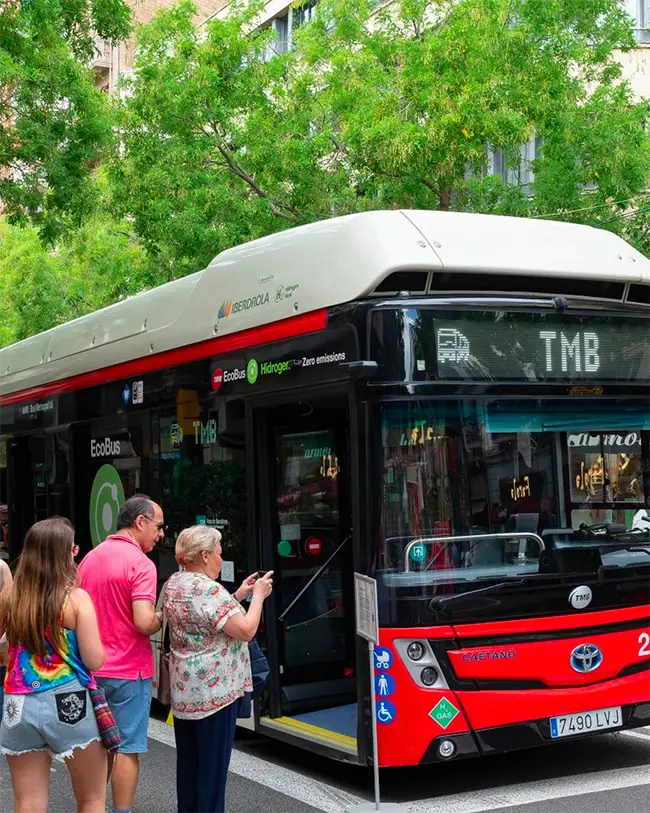

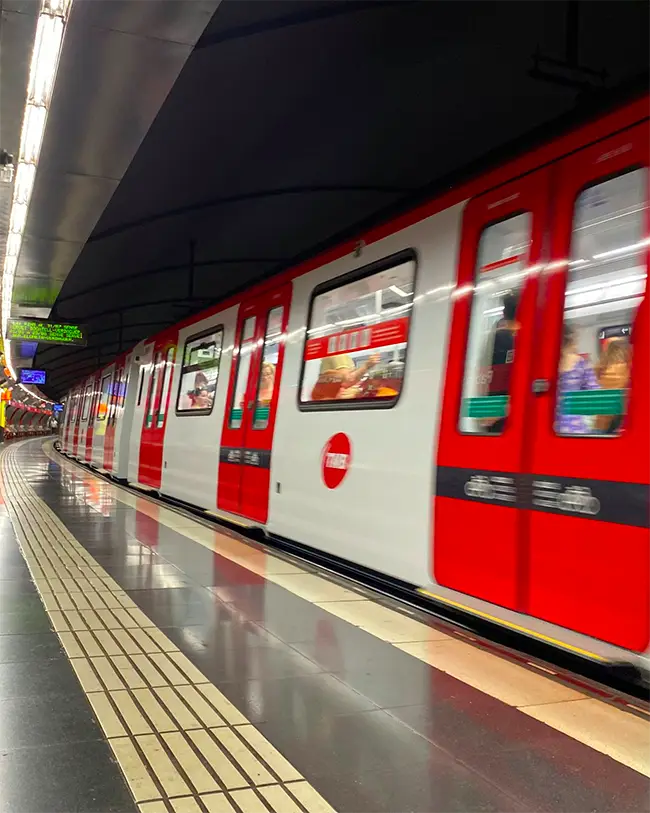
Queue jumping
One of the biggest frustrations in Barcelona, as in most popular tourist destinations, is the queues and crowds at the famous sights and activities. Standing in line for hours to buy a ticket before you even get into the place you want to see can really mess up your itinerary for the day. Plus, it’s no fun if you’re travelling with kids. That’s why it’s important to plan ahead and skip those queues!
Buying your tickets online for the big-name sites can save you so much time. You can save money, too, as some places are more expensive at the gate, and you risk them being sold out for the day. Also, when booking tickets, you can opt for a guided tour, which can improve your experience and deepen your understanding of what you’re seeing.
We recommend booking ahead for all the famous Gaudi buildings, including La Sagrada Familia, where the ticket queue can be two to three hours long in peak season. It’s also worth booking ahead for Barcelona Cathedral and the Picasso Museum, which offers limited free entry on certain days each month.
These days, you also need to book ahead for Park Güell. Although entrance to the park used to be free and unrestricted, the crowds were deemed detrimental to the UNESCO-heritage listed space. Now, visitor numbers are limited per hour, so book your ticket online to get an allocated time slot.
This might sound like a lot of forward planning for your trip, but it is 100% worth it when you can breeze past the queues and stroll straight into these fantastic sights. As an additional tip, we recommend planning to visit the famous sights early in the day or just before closing to avoid the worst of the crowds.

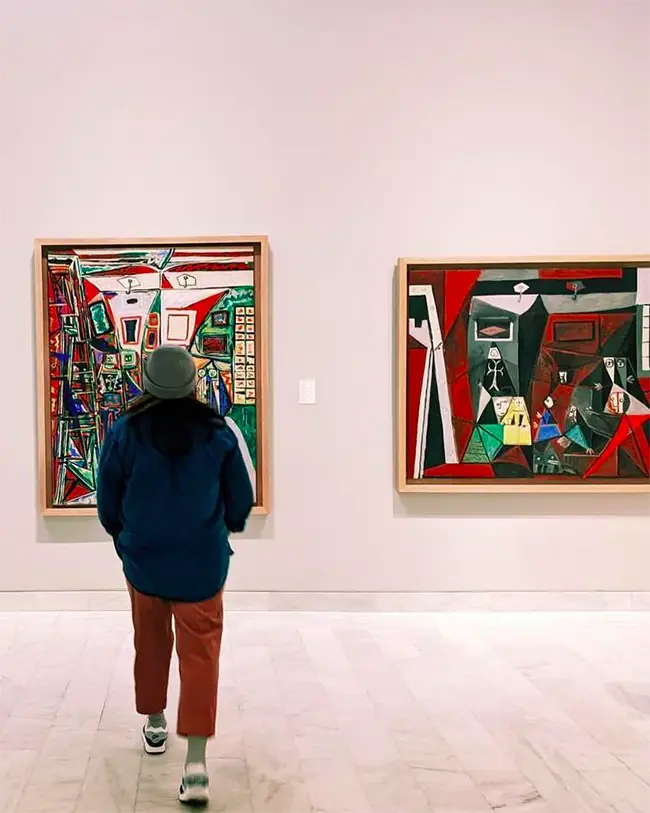
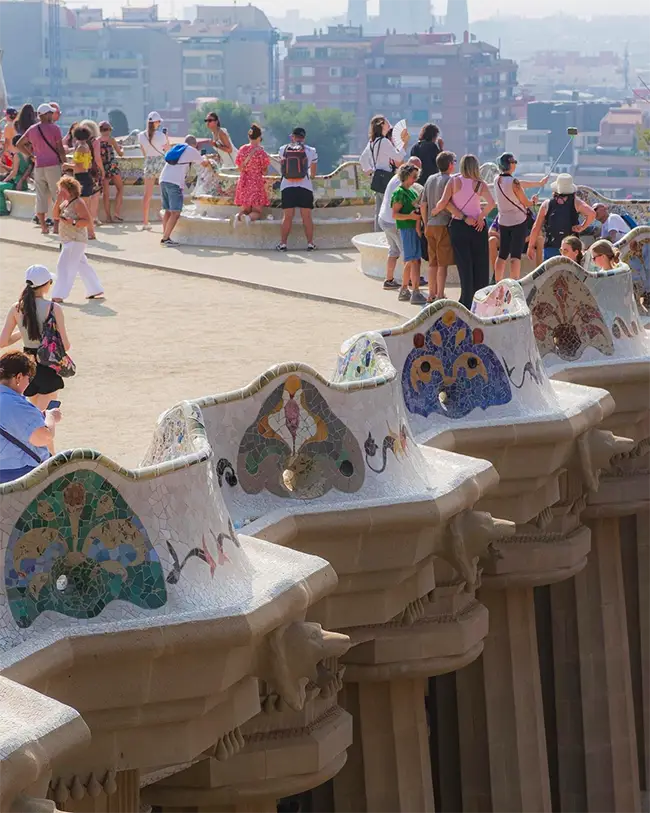
Ramblas
La Rambla (or Las Ramblas) is Barcelona’s most famous street and an absolute must-visit during your time there. Prepare for sensory overload as you wander this bustling street packed with vendors, markets, street performers, and pavement cafes. The great thing is that wandering along it is something that you can do for free, so great if you’re in Barcelona on a budget.
You’ll hear people talking disparagingly about La Rambla, complaining about the crowds and the rampant tourism of the strip. But if you look beyond the tacky souvenir stalls and overpriced sangria stands, you’ll see that this vibrant and beautiful tree-lined boulevard offers insight into the city’s daily life, history and culture. Plus, it’s a people watcher’s dream.
The 1.2 km strip from the Placa de Catalunya to the Port is split into five unofficial sections – hence why it is referred to as both La Rambla and Las Ramblas. Each one has it’s own sights and atmosphere:
- Rambla de Canaletes: The northernmost section is home to the famous Canaletes Fountain, the gathering place for FC Barcelona fans whenever the team wins a big game or championship.
- Rambla dels Estudis: Originally the location of the city’s bird market, which closed in 2010, it still hosts a few controversial pet stalls. Be sure to check out the Neo-classical Moja Palace, once home to one of Catalonia’s most famous poets.
- Rambla de Sant Josep: Better known as Rambla de les Flors because of the colourful and fragrant flower stalls lining the street. In this section, you’ll also find the Mercat de la Boqueria, a bustling food market where you can sample fresh produce, seafood, and a variety of local delicacies. Don’t miss the colourful and often overlooked Mosaic by Catalan artist Joan Miro.
- Rambla dels Caputxins: Here you’ll find the Gran Teatre del Liceu, Barcelona’s 2,300-seat opera house. Stop for drinks in the palm tree-lined Placa Reial, one of the city’s most beautiful squares, where you can take a break from the crowds and admire the 19th-century buildings and spot the Gaudi-designed lampposts.
- Rambla de Santa Monica: The last section of the avenue widens on its approach to the Port, culminating at the Mirador de Colom, a monument to Christopher Columbus. This artistic area is home to the Centre d’Art Santa Mónica, an arts and exhibition centre, and you’ll find street artists congregating here to create and sell their work.
The best way to visit La Rambla is to arrive early in the morning to enjoy the beauty of the boulevard and the buildings before the crowds arrive and then spend the day slowly strolling the length of it, marvelling at the many sights and cross-section of society on display. Around lunchtime, choose a cafe with a good view and watch as the avenue fills up with a chaos of crowds and street performers. Then, switch from coffee to cocktails and watch as the atmosphere changes again and evening revellers come out to play.
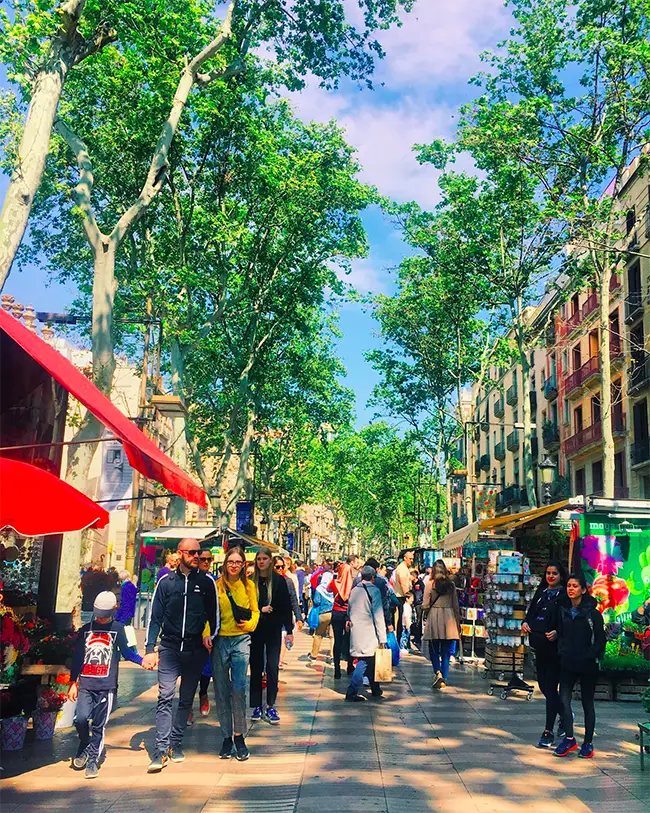
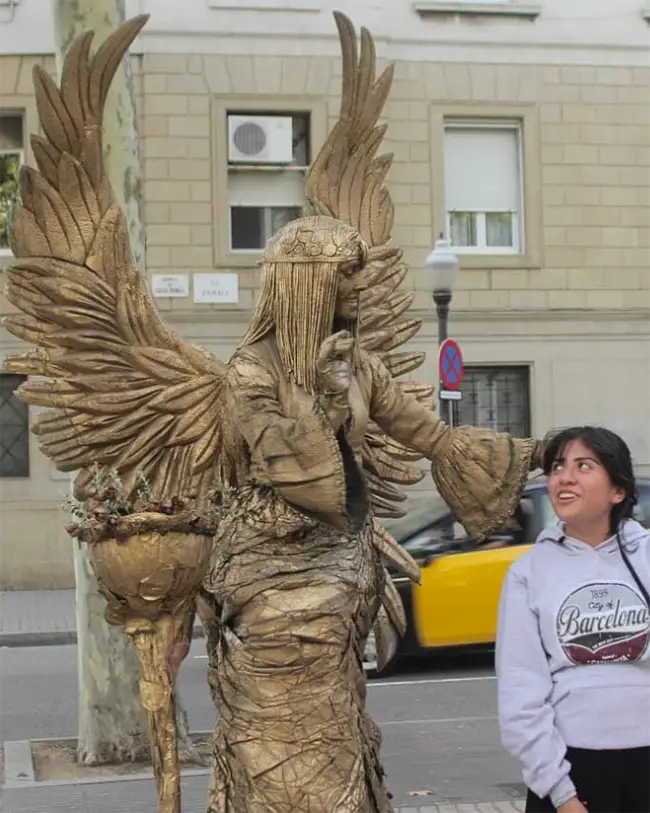
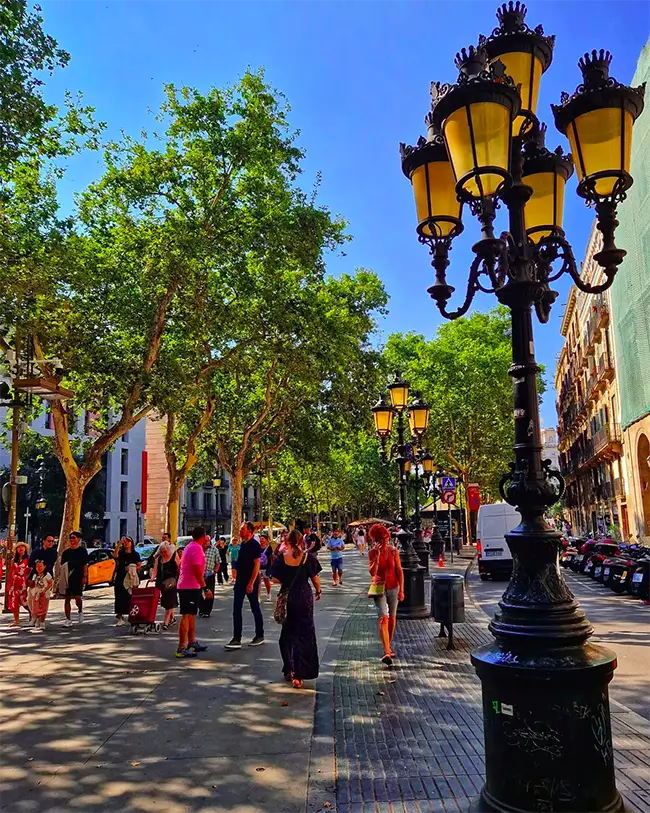
Sangria
Chances are, when you started planning your Barcelona break, you pictured yourself sitting in the sun outside some atmospheric little tapas bar sipping on sangria. Well, sorry to disillusion you, but you might want to rethink that order.
Although sangria is associated with Spain the world over, it might surprise you to hear that the Spaniards aren’t that bothered about it. You won’t catch many locals ordering sangria in a bar. It’s more something they’d drink at a house party or a barbeque, much like you’d serve alcoholic punch at a party back home.
That doesn’t mean you can’t find Sangria in Barcelona, of course, you can. Because the tourists expect it, you will find it for sale everywhere. But it’s not necessarily good. An authentic sangria needs to rest for a couple of hours or, ideally, overnight so that the fruit can infuse the wine with its flavours. In Barcelona’s busy tourist trap bars, this just doesn’t happen, and your ‘sangria’ will be whipped up on the spot. Many places will also fill it with sugar to mask the taste of cheap wine, then charge far more than the concoction is worth.
Instead, when out for an afternoon drink, why not do as the locals do and order a glass of Cava? It is a popular choice since this refreshing sparkling beverage is made in Catalonia. Another locally made favourite is sweet Vermouth drunk straight, on the rocks, or with just a splash of soda.
Or there’s Tinto de Verano, equal parts chilled red wine and lemonade. This light, refreshing beverage is sangria-esque but will gain you a little more local street cred when you order it.
Or, by all means, ignore this and live your sangria-drinking dreams while in Barcelona. Just be aware of where you’re drinking it. If you’re in a family-run establishment off the tourist track, you’re likely to get a much more authentic experience than in an Irish bar in the centre of the city. That being said, on my first trip to Barcelona, a group of friends and I ordered sangria on Las Ramblas, and it came in giant two-pint plastic steins with sparkly straws. Was it authentic or classy? No. Was it tasty and fun? Absolutely!
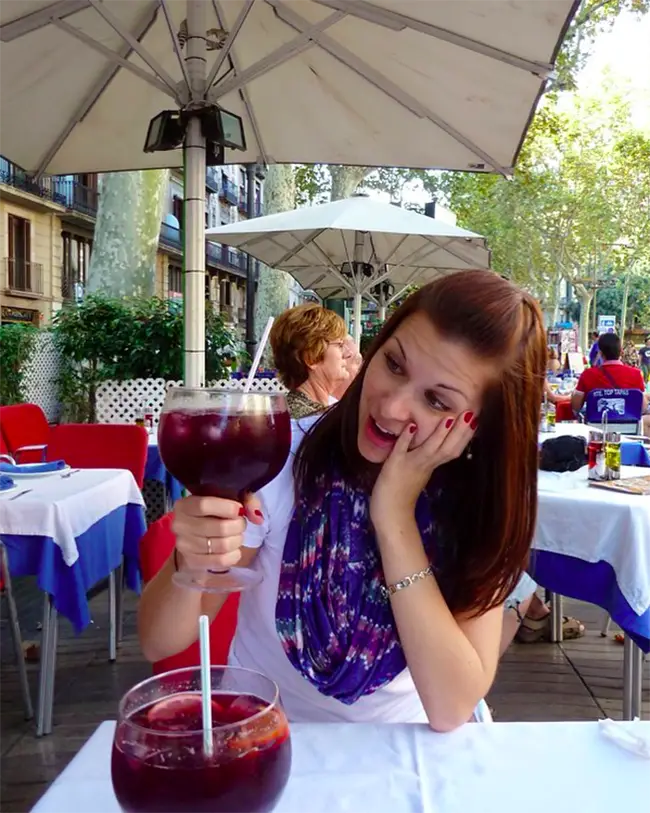
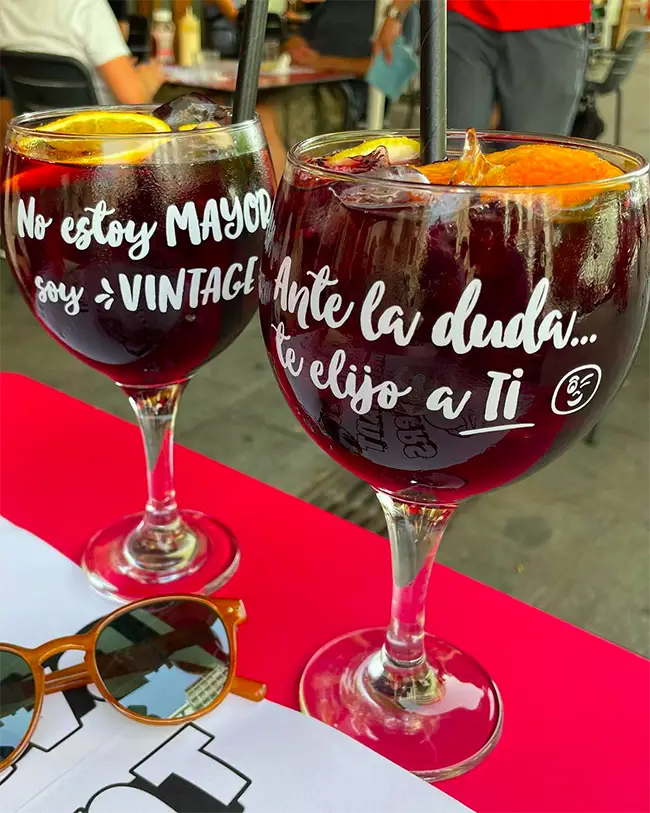
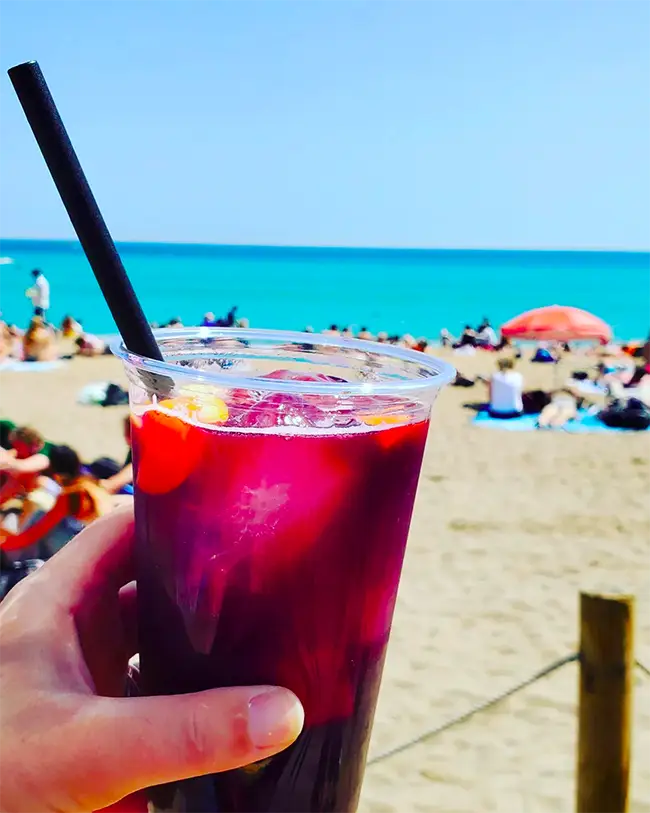
Tipping
Tipping – or propina – is not expected in Barcelona. As in many European cities, there is no compulsory tipping culture, and you won’t see the locals doing it. However, tourists are likely to over-tip through confusion and a desire to avoid causing offence, so here are the rules for when to tip and how much.
- In bars and cafes, there is no need to tip at all. You can leave some small change on your table to be friendly – such as rounding your bill up to the nearest euro – but you don’t need to and won’t be thought rude for not doing so.
- In restaurants, there is a growing trend for adding service charges to the bill; this will usually be 5-10% and should be clearly stated on both the menu and the receipt. You can leave an additional tip on top, but only if the service is exceptional. Hospitality workers in Barcelona are paid a full wage, so any tips they receive are a bonus, not a necessary addition to a low wage as they are in the US.
- Tipping taxi drivers is not expected. Do so only if you feel they’ve been extra helpful and friendly.
- With food and grocery deliveries, tipping is not compulsory but is common. Between €2 and €5 is fine.
- If you’re staying in a luxurious or old-fashioned hotel where the staff carry your luggage to your room for you, it’s reasonable to tip a euro or two per bag. In such establishments, leaving a tip for the housekeeping staff is common, too. But again, only do so if the service has impressed you.
- Lastly, if you take a tour, you can tip your guide as a thank you – between 5-10% of the tour cost – if you feel they were especially knowledgeable or friendly.
UNESCO
If you need further evidence of Barcelona’s cultural importance, how about the fact that it is home to no less than nine UNESCO World Heritage sites?
UNESCO, the United Nations Educational, Scientific, and Cultural Organization, gives its World Heritage Site status to cultural or natural landmarks deemed to have global significance. These sites are then protected and preserved for future generations to enjoy.
It probably won’t surprise you that seven of Barcelona’s nine UNESCO sites were created by Barcelona’s most famous son, Antoni Gaudí. These are Park Güell, Casa Milà, Casa Batlló, Palau Güell, Casa Vicens and the often-overlooked Cripta Güell, located just outside the city.
The iconic Sagrada Familia is also a heritage site, but not all of it. The UNESCO criteria are strict, and the unfinished Sagrada doesn’t meet all of them. Currently, only the Nativity Façade and the Crypt are designated heritage sites as these are the areas that Gaudi built in his lifetime. However, once the basilica is completed, UNESCO will reconsider whether the building as a whole meets its criteria.
But Gaudi doesn’t get all the UNESCO glory. Two buildings that made the heritage list were designed and created by Gaudi’s teacher and professional rival, Lluís Domenech i Muntaner.
Another Catalan-born architect, Domenech i Muntaner, was an intellectual, writer, teacher, nationalist politician, language expert and historian. He taught at the Barcelona School of Architecture for over twenty years. His students included Antoni Gaudi and Josep Puig i Cadafalch, a third famous disciple of the Catalan Modernism movement.
Domenech i Muntaner contributed many works to the architecture of Barcelona, but the Palau de la Música Catalana is his most famous and one of his two UNESCO heritage sites.
The concert hall was designed as a temple of the Catalan Renaissance in the early 20th century. It’s renowned for its stunning Art Nouveau architecture, incredible stained glass ceiling, groundbreaking use of steel and excellent acoustics.
The second of his UNESCO sites is The Hospital de Sant Pau. Built in the early 20th century this masterpiece of Catalan Modernism manages to combine beauty and art with the practical needs of a hospital building.
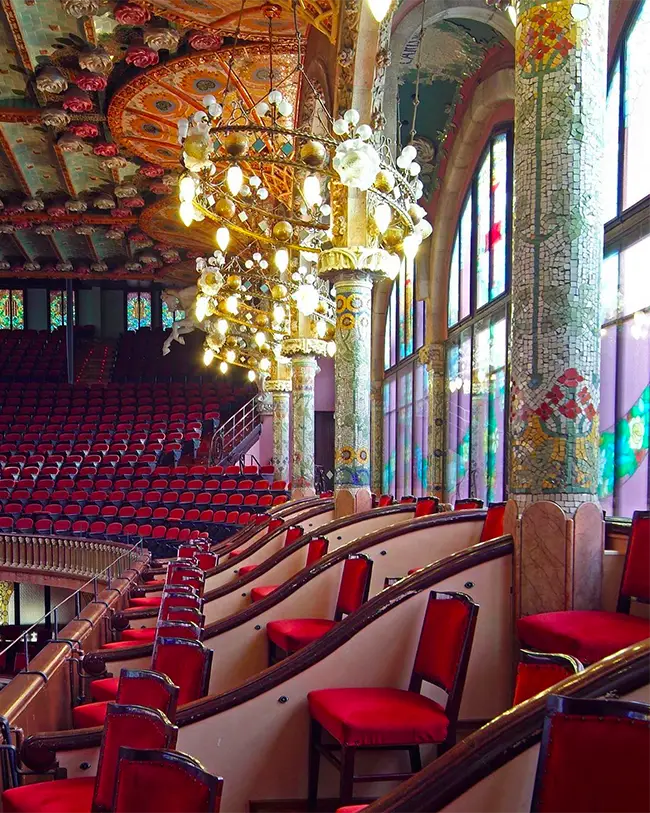
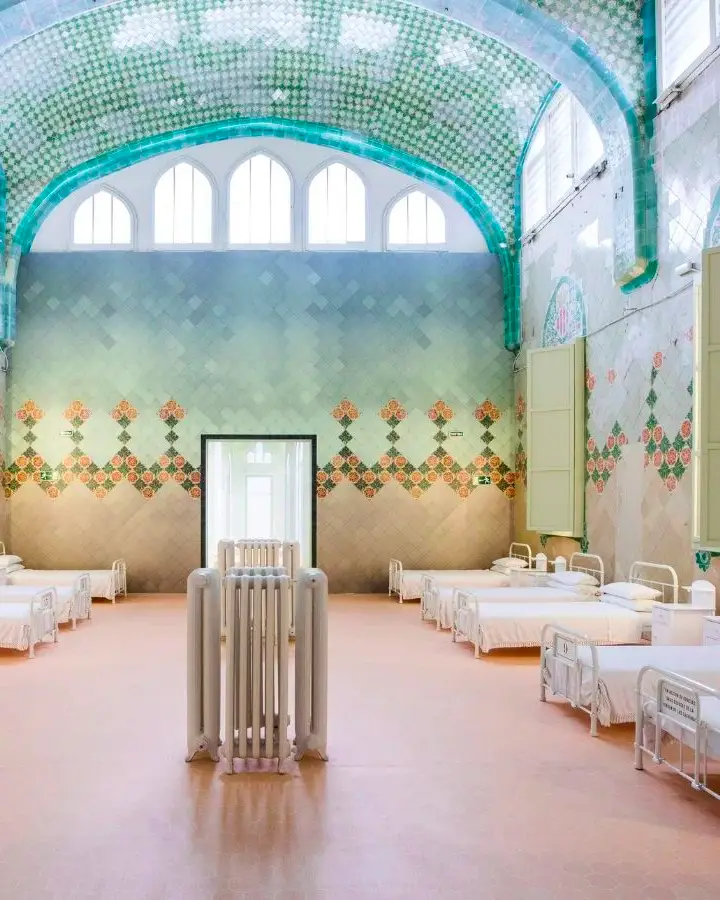
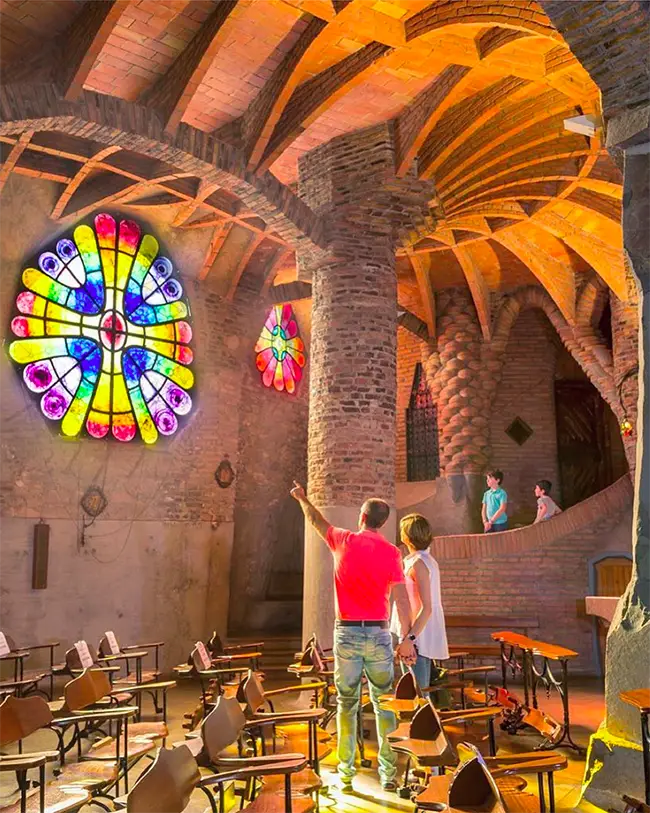
Vermouth
Vermouth might originate from Italy, but these days, Catalonians claim it as their own since it’s made in abundance in the region and is an extremely popular afternoon tipple in Barcelona.
You might know this fortified wine as little more than a basic cocktail ingredient (present in a Martini, Negroni or Manhattan). But the Catalan version tends to be sweeter and heavily laden with herbs and spices. The aromatic drink is enjoyed straight, over ice or with just a splash of soda. It is garnished with an olive and a lemon or orange slice and served with a little pre-lunch tapas.
The Spanish tradition of enjoying vermouth as a pre-lunch aperitif goes back decades. But the old-fashioned tradition is currently enjoying a resurgence in popularity, and these days in Barcelona, you’ll find the young hip crowd enjoying vermouth as their drink of choice. In fact, the phrase ‘fer un vermut’, literally to ‘do a vermouth’, has become common parlance for catching up with friends over drinks in the early afternoon.
Vermouth bars have been a staple of the city for centuries, but in response to this new popularity, modern vermouth venues are popping up beside the old ones. These bars compete to serve the best selection of vermouths, be they traditional, experimental or homemade, and of course, they pair them with a delicious selection of tapas.
Head to the Gracia neighbourhood to find the highest concentration of vermuteries and spend a few hours bar hopping to find your favourite vermouth recipe. It’s a fantastic way to spend an afternoon in the city. But be aware that vermouth time ends with the afternoon. To avoid standing out as a tourist, never order a vermouth after dark!
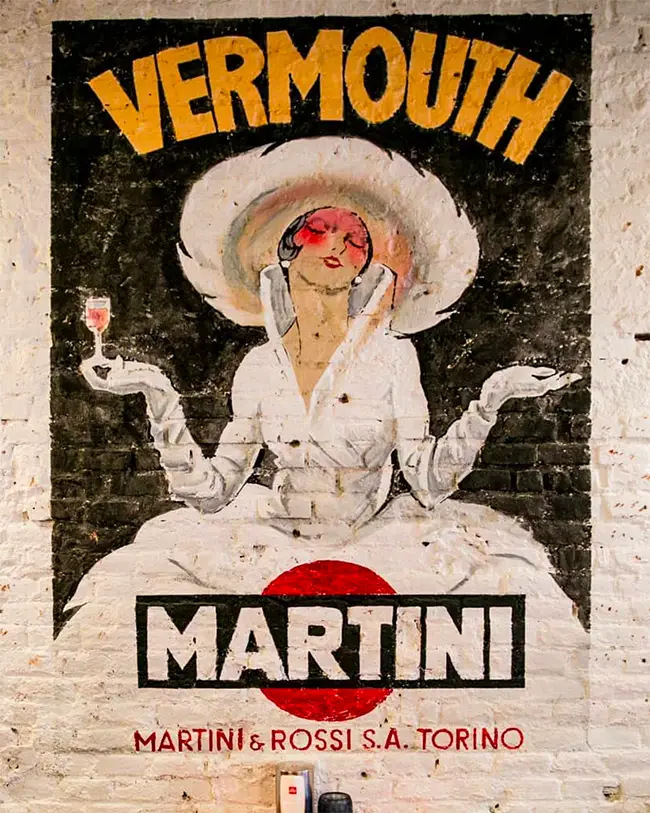
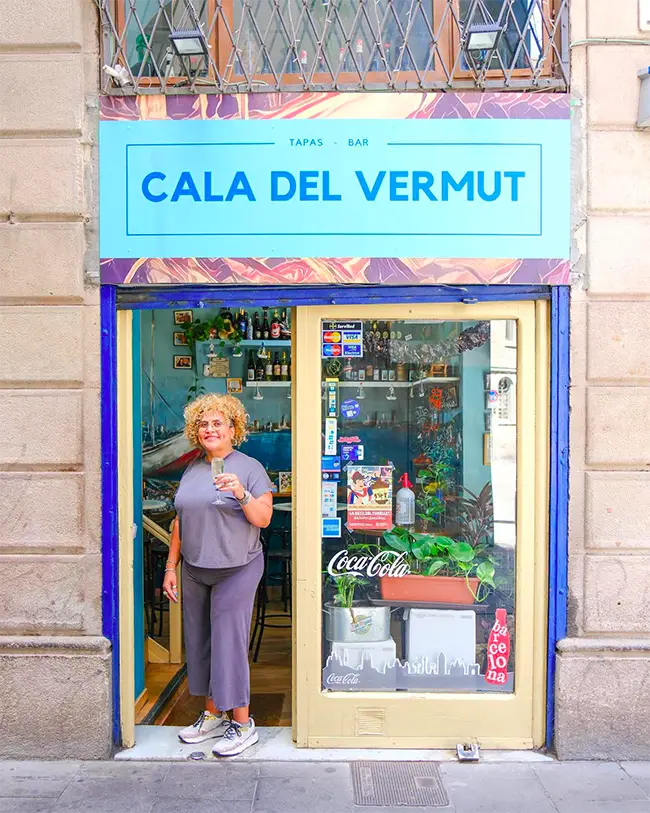
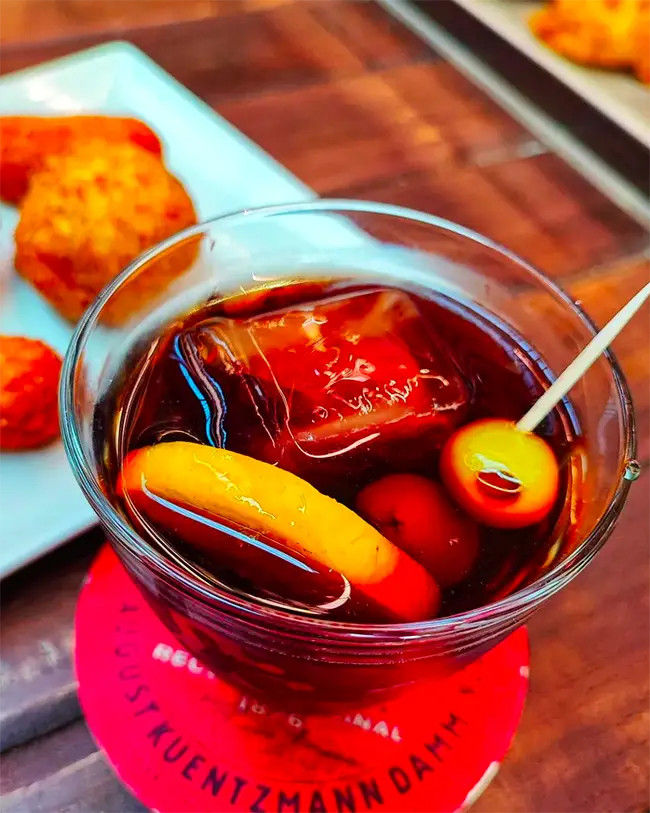
Walking
You’ll want to pack comfortable shoes for your trip to Barcelona, as it’s considered one of the world’s most walkable cities. This is partly because of the fabulous Mediterranean climate, and partly the forward-thinking city planning that created pedestrian zones, easily navigable grid street systems and plenty of green spaces. But it’s also because walking is just the best way to soak up the atmosphere and lifestyle of the city.
There are excellent walking routes all over. You can take a stroll along the bustling Ramblas, admiring the flower stalls, stopping at tapas stands and watching the street performers. Weave through the labyrinthine streets of the Gothic Quarter and the Ciutat Vella old town to immerse yourself in the city’s ancient history.
Explore the narrow lanes of El Ravel and the trendy streets of Gracia and El Born to stumble across hidden tapas bars, atmospheric cafes, boutique shops, contemporary street art and elegant squares. Wander the broad avenues of Eixample, admiring the fantastic architecture and window shopping in elegant designer stores.
Soak up some nature on a walk through one of the city’s many parks or up to Monjüic for stunning views and fascinating sights. Or visit the waterfront and stroll along the Passeig Marítim promenade to enjoy the vista of golden sand and sparkling sea on one side and an endless array of bars and cafes on the other.
Don’t want to wander aimlessly? Join one of Barcelona’s many walking tours hosted by knowledgeable local guides instead. There’s one for all tastes, so you can join a tour tailored to your interests, such as one that focuses on Gaudi’s architecture, architecture in general, or the city’s ancient or Civil War history. You can hunt down street art, sculptures and frescos, find the most luxurious shopping districts or visit the city’s best food stalls and markets.
Personally, I recommend taking a tapas tour to combine sightseeing with regular stops for authentic and delicious snacks!
What’s even better is that many of these tours are free or pay-what-you-wish tours. They are a fantastic way to get your bearings when you arrive in the city and they won’t break your budget!
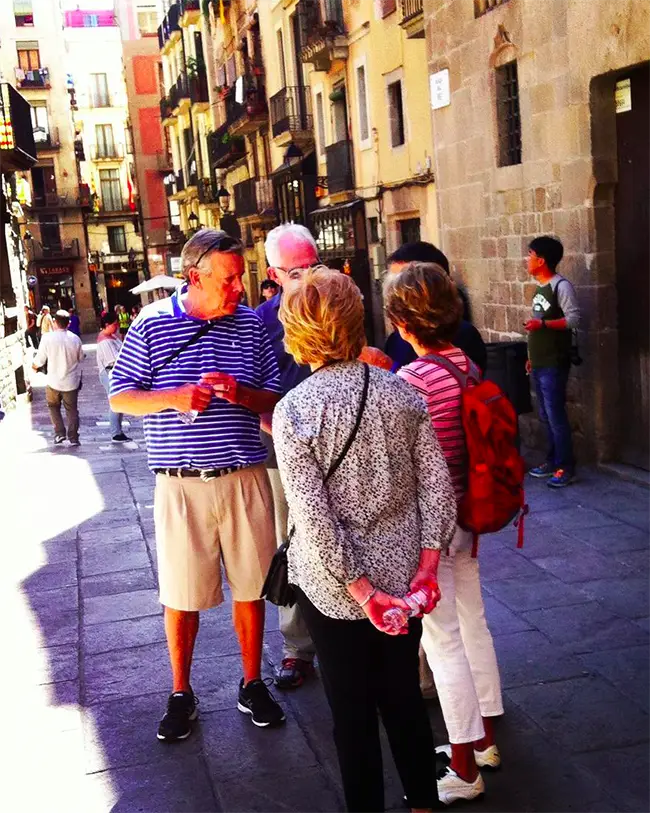
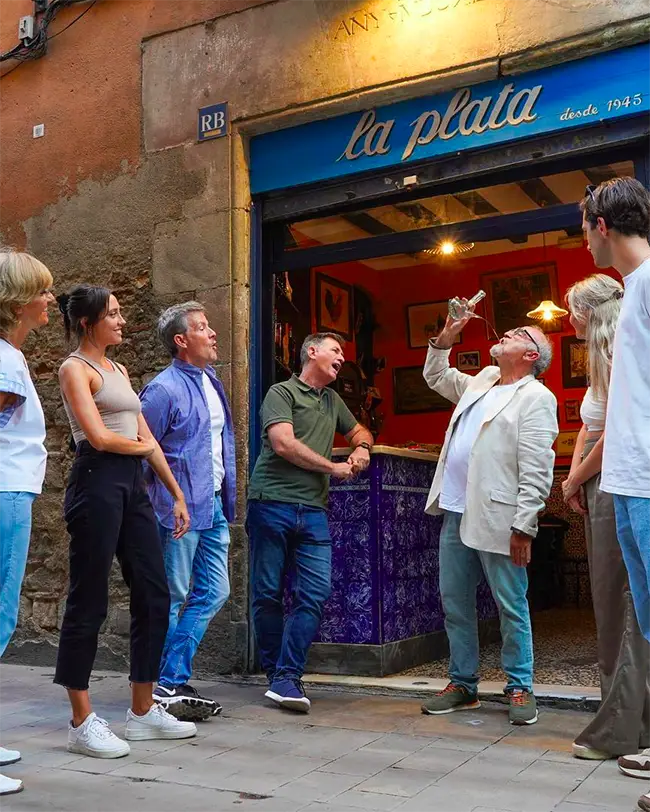
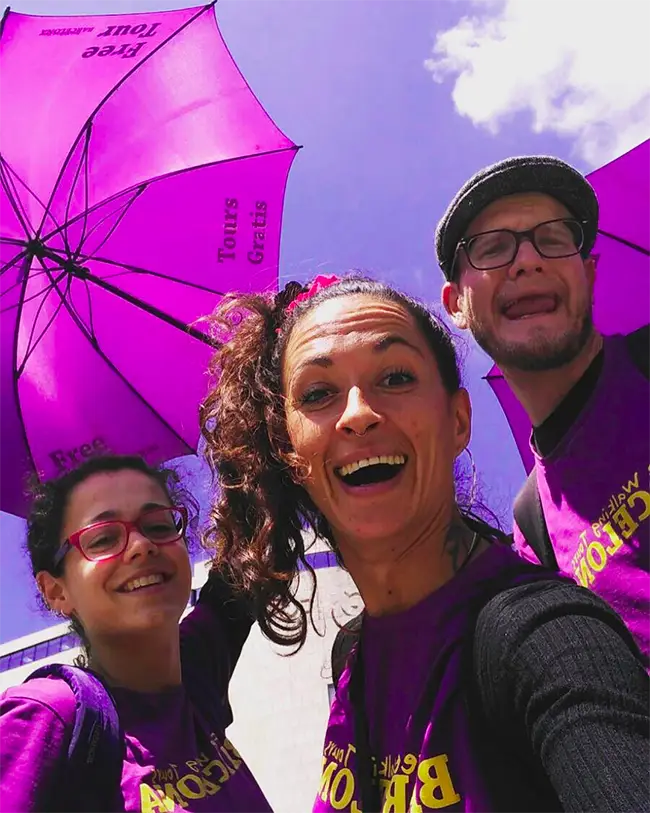
Weather
Barcelona enjoys a beautiful Mediterranean climate characterised by mild winters and hot, sunny summers.
The hottest month of the year is August when high temperatures average 29°C but often reach the 30s. The days are long and sunny, the tourists flock in, and it’s a great time to hit the beaches. It’s often too hot for locals who leave the city in droves. Those who stay make the most of siesta time between 1pm and 5pm to avoid the hottest part of the day.
Spring and autumn bring pleasant, sunny weather with comfortable temperatures ranging from 15°C to 24°C. It’s the ideal time to explore the city without overheating, and it’s still plenty sunny enough to enjoy the beaches. It can be wet in autumn, with October seeing the highest rainfall, but constant rain is uncommon.
Winters are typically mild, with average daytime temperatures ranging from 10°C to 15°C. Rainfall is most common between October and December, but it’s still pretty low compared to other European destinations. Snow and minus temperatures are rare, but the mercury can drop into single figures overnight, so remember to bring layers for the cool winter evenings.
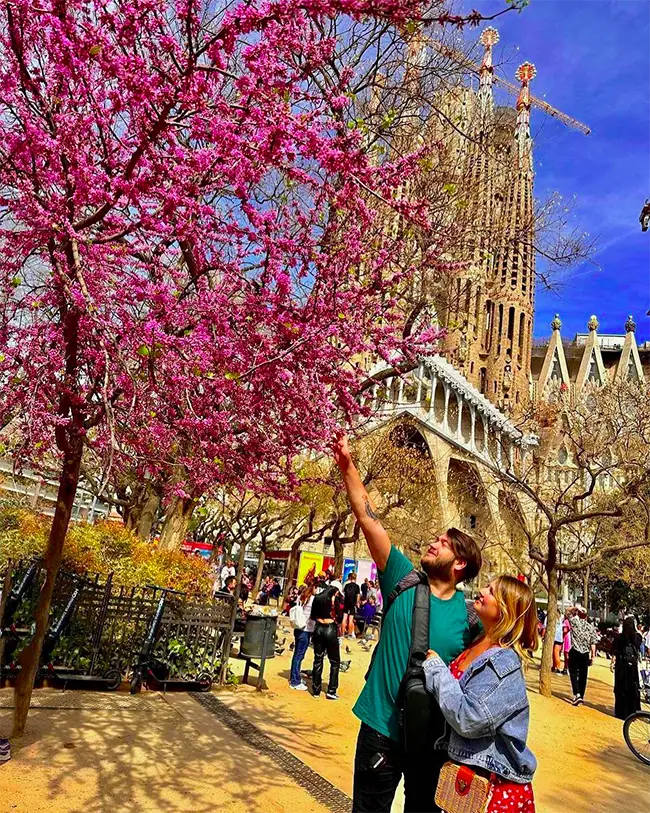

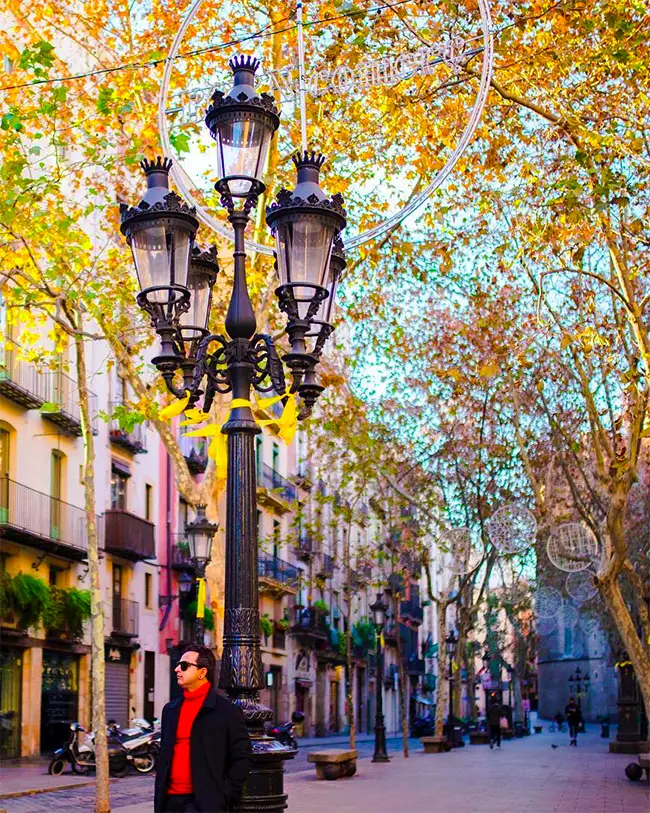
Xocolata Desfeta
Dessert lovers, listen up because this sweet treat is guaranteed to delight the taste buds. People refer to xcolata desfeta as ‘hot chocolate’, but a better translation of the Catalan is ‘melted chocolate’. This is a much better description, as this velvety mixture bears little resemblance to the watery cups of instant chocolate you’ve had before.
Proper xocolata desfeta is made from grated slabs of spiced chocolate and served so thick you have to eat it with a spoon. Or, better still, with biscuits, chunks of sponge cake or freshly made Churros.
It’s a much-loved dessert in Spain, and you’ll find it on the menu in plenty of cocoa-scented cafes in the city. And, if you visit during the festive season, you’ll find local Catalonians enjoying a bowl of melted chocolate as a sacred ritual after midnight mass on Christmas Day.
Xocolata Museum
For true chocolate lovers, a trip to the Museu de la Xocolata is a must! This museum, dedicated to the history of chocolate in Europe, explains Barcelona’s love for the stuff, which goes back 500 years to when the first precious cocoa beans and chocolate recipe were smuggled back to Spain from South America.
Read the conflicting accounts of who was the first to bring Chocolate to the shores of Europe and learn about Barcelona’s role in importing and preparing the precious commodity. Discover how it was first consumed by the elite of Spanish society as a hot spiced drink before the ‘chocolate frenzy’ spread across the continent to reach every country and level of society.
The Chocolate Museum makes a great day out. As well as discovering the history of this beloved substance, chocolate fans of all ages can admire the changing array of chocolate exhibits and take part in interactive workshops and chocolate-making courses. And, of course, tastings! Because at this museum, eating chocolate is not just an indulgence but a cultural celebration!
Zoo Barcelona
An excellent way to spend an afternoon with family is to visit the Parc Zoològic de Barcelona. Located in the heart of the city in the Parc de la Ciutadella, this zoo has been open since 1892. The beautifully landscaped and maintained space covers 13 hectares and contains thousands of animals and over 400 species.
Wander through the park, marvelling at big cats, gorillas, hippos, komodo dragons, penguins, reptiles, insects, flamingos and giraffes. And for less exotic but more accessible animals, there is a petting zoo where kids can get up close with the sheep and goats. There’s also an adventure playground and picnic areas, so you can make a full day of it.
Barcelona Zoo has a commitment to conservation and works with numerous environmental programs and initiatives to protect endangered species and their natural habitats. In addition, the zoo makes it its mission to provide educational activities and areas so visitors can learn about the importance of conservation. It’s a wonderful place for families, kids, nature and wildlife lovers to spend a day.



There you go!
So there you go, our A- Z guide to Barcelona! Hopefully, this has given you a good place to start for your Barcelona research, and you now feel even more inspired to plan your dream trip. Maybe you can picture yourself admiring the city’s architecture, swimming in sparkling seas, sampling delicious tapas and sipping an afternoon vermouth.
But if you still have questions or you think we’ve left out something important – maybe we missed your favourite spot in the city or overlooked a cultural festival you’d like to know about – if so, let us know! We’ll do our best to answer your questions and include anything we’ve missed!
In the meantime, happy holiday planning, and we’ll see you on Las Ramblas!
I have been lucky enough to visit Barcelona several times, each for a different reason. I have experienced it on a romantic escape with a partner, on a wild weekend hen party with friends and on city breaks as a solo traveller. Each trip has revealed a different side of the city to me as I strolled the atmospheric streets, revelled in the nightlife, immersed myself in the culture and – on every trip – enjoyed the exceptional food. And I have no doubt that I have plenty more to see on future trips.
